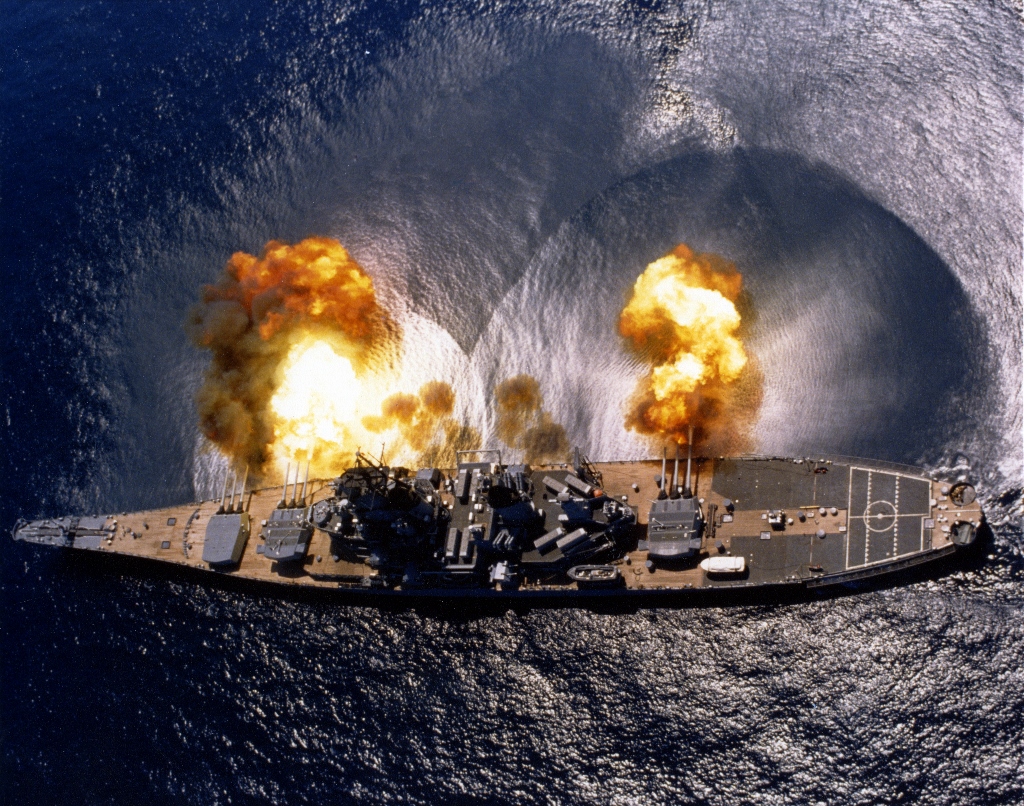
More powerful than the 16"/45 (40.6 cm) Mark 6 guns used on the North Carolina (BB-55) and South Dakota (BB-57) classes, this was possibly the best battleship gun ever put into service. Originally intended to fire the relatively light 2,240 pound (1,016.0 kg) AP Mark 5 projectile, the shell handling system for these guns was redesigned to use the "super-heavy" 2,700 pound (1,224.7 kg) AP Mark 8 before any of the USS Iowa class (BB-61) battleships were laid down. This heavier projectile made these guns nearly the equal in terms of penetration power to the 46 cm (18.1") guns of the Japanese Yamato class battleships, yet they weighed less than three-quarters as much.
As modernized in the 1980s, each turret carried a DR-810 radar that measured the muzzle velocity of each gun, which made it easier to predict the velocity of succeeding shots. Together with the Mark 160 FCS and better propellant consistency, these improvements made these weapons into the most accurate battleship-caliber guns ever made. For example, during test shoots off Crete in 1987, fifteen shells were fired from 34,000 yards (31,900 m), five from the right gun of each turret. The pattern size was 220 yards (200 m), 0.64% of the total range. 14 out of the 15 landed within 250 yards (230 m) of the center of the pattern and 8 were within 150 yards (140 m). Shell-to-shell dispersion was 123 yards (112 m), 0.36% of total range.
The Armor Piercing (AP) shell fired by these guns is capable of penetrating nearly 30 feet (9 m) of concrete, depending upon the range and obliquity of impact. The High Capacity (HC) shell can create a crater 50 feet wide and 20 feet deep (15 x 6 m). During her deployment off Vietnam, USS New Jersey (BB-62) occasionally fired a single HC round into the jungle and so created a helicopter landing zone 200 yards (180 m) in diameter and defoliated trees for 300 yards (270 m) beyond that.
A persistent anecdote is that the Iowa class suffered from alignment problems until after the Battle of Leyte Gulf. William Jurens, a noted expert on US naval weaponry, together with Iowa crewmembers and the staff at NSWC Dahlgren, performed a search of the official records for detailed data on this specific problem, but could find nothing in the files suggesting that the alignments were in any way out of the ordinary. Mr. Jurens' suspicion is that there may have been an oblique reference to an alignment problem in some document that was taken out of context; perhaps they were waiting for parts.
The Iowa class battleships were the last survivors of the battleship era to be placed into service, but they now exist mainly as memorials. The big-gun battleship era ended on 16 May 1991, when USS Wisconsin (BB-64) emptied her barrels for the last time.
The weapon is constructed of liner, A tube, jacket, three hoops, two locking rings, tube and liner locking ring, yoke ring and screw box liner. Some components were autofretted. As typical of USN weapons built in the 1940s, the bore was chromium plated for longer barrel life. Uses a Smith-Asbury Welin breech block which opens downwards. The screw box liner and breech plug are segmented with stepped screw threads arranged in fifteen sectors of 24 degrees each. A manually operated lever is used to rotate and unlock the breech plug, which is then pulled opened manually. After loading, the breech plug is swung back up into the breech by a pneumatic system. The manually operated lever is then used to rotate and lock the breech closed. When the plug is locked, the breech lever engages the salvo latch mechanism which prevents the breech from being opened again until after the gun fires.
| Designation | 16"/50 (40.6 cm) Mark 7 |
|---|---|
| Ship Class Used On | Iowa (BB-61) and Montana (BB-67) Classes |
| Date Of Design | 1939 |
| Date In Service | 1943 |
| Gun Weight | 267,904 lbs. (121,519 kg) (including breech)
239,156 lbs. (108,479 kg) (without breech) |
| Gun Length oa | 816 in (20.726 m) (breech face to muzzle) |
| Bore Length | 800 in (20.320 m) |
| Rifling Length | 682.86 in (17.344 m) |
| Grooves | (96) 0.150 in deep (3.81 mm) |
| Lands | N/A |
| Twist | Uniform RH 1 in 25 |
| Chamber Volume | 27,000 in3 (442.5 dm3) |
| Rate Of Fire | 2 rounds per minute |
- The primer cartridge can be fired either electrically or by percussion. The cartridge is automatically ejected when the breech opens after firing. In the case of a misfire, the cartridge can be manually removed and replaced without opening the breech.
- The bore was chromium plated for a distance of 690 inches (17.526 m) from the muzzle.
- Projectile travel was 689.67 in (17.518 m) (new gun).
- Air purging was used on these guns in order to quench and remove smoldering particles as a preventative measure against flareback. In movies or pictures, this purging can be seen as a small puff of white smoke that is emitted a few seconds after the gun fires.
| Type | Bag |
|---|---|
| Projectile Types and Weights | World War II and Korean War Deployments
AP Mark 8 Mods 0 to 8: 2,700 lbs. (1,225 kg) 1a 2a HC Mark 13 Mods 0 to 6: 1,900 lbs. (862 kg) 3a HC Mark 14 Mod 0: 1,900 lbs. (862 kg) 3a Target Mark 9 Mods 1 & 2: 2,700 lbs. (1,225 kg) 4a Target Mark 15: 1,900 lbs. (861.8 kg) 5a Added during 1950s Deployments
Added during 1967-69 Deployment 7a Added during 1980s - 1990s Deployments
9a 10a |
| Bursting Charge | AP Mark 8: 40.9 lbs. (18.55 kg) Explosive D
HC Mark 13: 153.6 lbs. (69.67 kg) Explosive D HC Mark 14: 153.6 lbs. (69.67 kg) Explosive D Nuclear Mark 23: W23 warhead, about 15-20 kilotons HE Mark 19: 400 M43A1 grenades HE-CVT Mark 143: 153.6 lbs. (69.67 kg) Explosive D
Sub-munitions for Mark 19, Mark 144, Mark 146 and Mark 148 projectiles
|
| Projectile Length | AP Mark 8: 72.0 in (182.9 cm)
HC Mark 13: 64.0 in (162.6 cm) HC Mark 14: 64.0 in (162.6 cm) Nuclear Mark 23: 64.0 in (162.6 cm) HE Mark 19: 63.6 in (161.5 cm) HE-CVT Mark 143: 64.0 in (162.6 cm)
|
| Propellant Charge 11a 12a | Full Charge for AP or HC: 660.0 lbs. (299.4 kg) SPD 839 13a Full Charge for HC: 593 lbs. (269 kg) SPD D846 14a Reduced Charge: 305.0 lbs. (138.3 kg) SPD 840 or SPDN 15a Reduced Flashless Charge: 325.0 lbs. (147.4 kg) D845 or SPCG |
| Muzzle Velocity 16a 17a | AP Mark 8: 2,500 fps (762 mps) (new gun)
AP Mark 8: 2,425 fps (739 mps) (average gun) AP Mark 8: 1,800 fps (549 mps) (reduced charge) HC Mark 13: 2,690 fps (820 mps) (new gun)
HC Mark 147(?): 2,825 fps (861 mps)
|
| Working Pressure | 18.5 tons/in2 (2,910 kg/cm2) 18a |
| Approximate Barrel Life | 290 rounds 19a |
| Ammunition stowage per gun | About 130 rounds 20a |
- ^Approved in June 1939, the AP Mark 8 projectile was originally designed as the longer, heavier "big brother" to the AP Mark 5 projectiles used for the 16"/45 (40.6 cm) guns carried by the Colorado (BB-45) class battleships. Like the Mark 5, the Mark 8 projectiles were designed to be used in long-range gun actions against Japanese ships ("Plan Orange") and for that reason they were to be fired at relatively low muzzle velocities and high gun elevations. These conditions would result in a steeper angle of fall in order to enhance their deck armor penetration capabilities. In almost all respects the 1939 design of the Mark 8 Mod 0 was very similar to the Mark 5 except for length. However, around the end of 1944 the improved Mark 8 Mod 6 version came out with significantly better hardening techniques which gave a noticeable improvement in penetration at impact angles of 35 degrees or so against thick face-hardened armor. This performance was so much better that BuOrd put out a memo stating that battleships were to return all previous Mods of this projectile as quickly as the Mod 6 became available for loading aboard ship. The Mod 6 had an even blunter, rounded AP body nose (with no point) to further enhance penetration against deck armor at high obliquity. The Mod 8 had a heavier cap, blunter nose and harder body from improved heat treating techniques. The AP Mark 8 has a radius of ogive of 144 inches (366 cm) or 9crh and leaves the barrel rotating at about 70 RPS. This round creates overpressures exceeding 50 psi (3.5 kg/cm2) close to the muzzle and 7 psi (0.5 kg/cm2) at a distance of 50 feet (15 m) from the muzzle. The Mark 21 Base Detonating Fuze (BDF) had a delay of 0.033 seconds. Fuze activation required a resistance equal to 1.5 inches (3.8 cm) of armor at 0 degrees obliquity or 0.375 inches (1 cm) at 65 degrees obliquity. AP projectile bodies are painted black. The nose color indicates burster type, with yellow denoting Explosive D. A narrow colored band below the nose indicates the splash color. Used Mark 21 Mods 0-3 Base Fuzes. AP Mark 8 Mods 6-8 were redesignated as Mark 139 Mod 0 in the 1980s. Earlier Mods were no longer in service and were not redesignated.
- ^The AP Mark 8 had a nominal 1.5 lbs. (0.68 kg) dye bag but this was allowed to be as large as 3.0 lbs. (1.36 kg) in order to bring underweight projectiles up to standard. The Iowa class was assigned the following dye colors:
USS Iowa - Orange
USS New Jersey - Blue
USS Missouri - Red
USS Wisconsin - Green - ^3.13.2The HC Mark 13 was originally designed for the Colorado (BB-45) class battleships, whose shell handling system limited the maximum projectile length to about 4 calibers. For standardization purposes, the Mark 13 was also issued to all of the newer battleships, even though their shell handling systems could accommodate a longer, heavier projectile. This much-needed projectile was introduced in late-1942 and was originally designated as the EX-1. The explosive cavity in the Mark 13 has a relatively thick-wall with a fairly constant sidewall thickness, getting slightly thicker at the nose. It had somewhat less explosive weight in terms of percent than most foreign projectiles of World War II or even earlier USN HE projectiles, since it had as one of its requirements the ability to penetrate light armor and heavy concrete for shore bombardment purposes. The Mark 13 uses both a base delay and nose contact fuzes for greater reliability under differing conditions, but can be used with only one fuze if desired. During World War II BuOrd developed AA shells for these guns which were standard HC rounds with a mechanical time fuze replacing the usual nose contact fuze. This meant that the function of the ordnance could easily be changed by simply replacing the nose fuze. These AA shells do not appear to have been issued their own Mark number, as they seem to have been known simply as the HC Mark 13 AA round. Like the AP Mark 8, the HC Mark 13 projectile has a radius of ogive of 144 inches (366 cm) or 9crh. The Mark 14 is identical to the Mark 13, being simply a different designation assigned to indicate manufacturers other than the Naval Gun Factory. The Naval Surface Warfare Center - Crane Division located at Crane, Indiana, manufactured some HC projectiles in 1969 and these were designated as Mark 14, but they were otherwise identical to the Mark 13. HC projectile bodies are painted green. The nose color indicates burster type, with yellow denoting Explosive D. Used one of the following Nose Fuzes - Mark 29 (P.D.F.), Mark 42 or Mark 62 (M.T.F.) or a Nose Plug - projectile was usually issued with a nose plug which could be changed out for a nose fuze on-board ship. The Nose Fuze mated with one of the following Auxiliary Detonating Fuzes - Mark 17 (green stripe), Mark 35 or Mark 55. To ensure detonation, either the Booster Mark 5 or a special 0.53 lbs. (0.24 kg) pressed TNT block was used under the Auxiliary Fuze. Base Fuzes - Mark 28 (green stripe); Mark 39, or Mark 48. At the time of the Korean War, an HC projectile cost $1,352. In the 1980s, Mark 13 and Mark 14 projectiles were both redesignated as Mark 140 Mod 0. Other Mark 13 projectiles were given different fuzes and these were then redesignated as the Mark 143 and Mark 145. See below.
- ^4.14.24.3Target Mark 9 used blind loaded and plugged (BL&P) AP Mark 8 projectile bodies. Mods 1 and 2 denote different manufacturers. The Target Mark 10 was identical to the Mark 9 but used a dye spotting load. These were given the same dye colors as those issued for the AP rounds. The later Target Mark 18 projectiles were apparently converted AP Mark 8 Mods 0 to 5 shells after they were withdrawn from service with the introduction of the improved AP Mark 8 Mod 6. The Mark 18 Target projectiles were given dye loads like the Target Mark 10.
- ^A total of fifty Mark 23 "Katie" nuclear projectiles were produced during the 1950s with development starting in 1952 and the first service projectile being delivered in October 1956. It is possible that the W23 nuclear warhead used for this projectile may have been installed inside of an otherwise unaltered HC Mark 13 shell body, although one of the sources listed below says that the projectile was slightly smaller than the Mark 13. USS Iowa, USS New Jersey and USS Wisconsin had an alteration made to Turret II magazine to incorporate a secure storage area for these projectiles. USS Missouri was not so altered as she had been placed in reserve in 1955. This secure storage area could contain ten nuclear shells plus nine Mark 24 practice shells. These nuclear projectiles were all withdrawn from service by October 1962 with none ever having been fired from a gun. One projectile was expended as part of Operation Plowshare (the peaceful use of nuclear explosive devices) and the rest were deactivated. USS Wisconsin did fire one of the practice shells during a test in 1957. It is not clear whether or not any of the battleships ever actually carried a nuclear device onboard, as the US Navy routinely refuses to confirm or deny which ships carry nuclear weapons. At least one Mark 23 shell body still exists at the National Atomic Museum in Albuquerque, New Mexico, as can be seen in the photograph below.
- ^In the spring or summer of 1967 when USS New Jersey (BB-62) was being activated for Vietnam, Indian Head Naval Ordnance Station proposed taking 23,000 non-nuclear 280 mm (11") shells left over from the Army's "atomic cannon" program and converting them via a sabot and obturator so that they could be used in 16" (40.6 cm) guns. This was apparently a part of or in conjunction with the "Gunfighter" program for developing Long Range Bombardment Ammunition (LRBA) projectiles. The program seems to have been halted when New Jersey was decommissioned in 1969. A photograph of the disassembled saboted round is shown below. During the 1980s deployment, an investigation was undertaken to consider converting 280 mm projectiles into cargo rounds carrying about 300 sub-munitions, but no prototypes were constructed.
- ^The HE Mark 19 projectile was apparently developed when USS New Jersey (BB-62) was activated for the Vietnam War. This new munition used a projectile body based upon that of the HC Mark 13 modified to carry a cargo of 400 sub-munition M43A1 "Bouncing Betty" grenades arranged in 20 rows of 20 grenades each. The HE Mark 19 used the Army M565 Mechanical Time fuze to detonate an expelling charge of 400 grams of M9 mortar propellant to push out the grenades. The fuze timing movement was a spring-driven clockwork mechanism secured in the unarmed position by setback pins and centrifugal detents. A time scale graduated from 0 to 100 seconds was inscribed on the rotatable lower cap, and a vernier scale to permit setting accuracy to 0.1 seconds appeared on the base. The grenades were an impact fuzed type that expelled a fragmentation charge upwards for airburst. The HE Mark 19 apparently did not go into service, as USS New Jersey was suddenly decommissioned after her first deployment and did not return to Vietnam. The 1981 inventory search (see below) found that none of existing rounds were serviceable and the projectile bodies were then used to create the new Anti-Personnel ICM Mark 144 projectile (see below).
- ^A 1981 inventory of naval ammunition storage facilities found that there were the following 16"/50 (40.6 cm) munitions in stock:
16"/50 (40.6 cm) Projectiles Available as of 1981 Munition Total Quantity Estimated Percent Serviceable Quantity Serviceable 16"/50 HC Projectiles 15,450 51 7,950 16"/50 AP Projectiles 3,200 90 2,880 16"/50 Target Projectiles 2,300 100 2,300 16"/50 Mark 19 Projectiles 138 0 0 Total 21,088 ------ 13,130 16"/50 (40.6 cm) Charges Available as of 1981 Charges Total Quantity Estimated Percent Serviceable Quantity Serviceable 16"/50 Full Charges 12,462 90 11,200 16"/50 Reduced Charges 12,589 90 11,330 Total 25,051 ------ 22,530 In addition to complete projectiles and charges on hand, there were sufficient components available to assemble 4,970 HC Projectiles, 81 AP Projectiles and 6,930 Full Charges. The Navy estimated in 1981 that the existing serviceable inventory was equivalent to a 23 ship - year supply for training and structural tests, assuming 100 rounds per ship per year, but that target projectiles would be exhausted by the end of calendar year 1991. At the time of the 1981 estimate, a plan was in place to repair as many of the unserviceable projectiles and charges as possible, but how many of these were actually made useful again is unknown at this time.
- ^During the 1980s deployments, several new projectile assemblies including ones based upon the HC Mark 13 and HE Mark 19 projectile bodies were developed or planned. Some of these were in service during the Gulf War (1990).
HE-CVT Mark 143
HC Mark 13 projectile with the Army M732 Controlled Variable Time (CVT) nose fuze. These fuzes provided a 20 foot (6 m) burst height for shore bombardments.Anti-Personnel Improved Conventional Munition (ICM) Mark 144
This was the reconditioned HE Mark 19 using the Army M724 Electronic Time Fuze (ETF) instead of the M565 nose fuze. The M725 could be set for times between 0.2 to 200 seconds in increments of a tenth of a second. Like the Mark 19, the ICM Mark 144 had a payload of 400 M43A1 anti-personnel grenades. The ICM Mark 144 was considered exceptionally effective against personnel, aircraft and other "soft" targets. See sketches for the HE Mark 19 and the ICM Mark 144 below.HE-ET/PT Mark 145
HC Mark 13 projectile with Mark 423 Point-Detonating (PD) nose fuze and Mark 48 Mod 4 base fuze. In 1986 there was a project authorized to convert some of these to have an ASW function - details unknown. Some of these were fired by USS Iowa (BB-61) during tests in 1989.Anti-Personnel ICM Mark 146
Similar to the ICM Mark 144 and used the same M724 Electronic Time Fuze, but contained a total of 666 M42, M46 and M77 sub-munitions which are Dual Purpose Improved Conventional Munitions (DPICM) bomblets. These are all cylindrical bodied designs of the same size and incorporate an impact inertia fuze. The grenades are equipped with a ribbon stabilizer which also arms the fuze in flight. The M46 grenade differs from the M42 and M77 in having a heavier, thicker body with a smooth inner wall. ICM Mark 146 Mod 2 was similar to the Mod 1 but had a threaded base plug to simplify renovation. See sketch below.Improved HC Mark 147(?) (Planned)
During the battleship reactivations of the 1980s, the Navy developed a new HC shell design that was the same length as the AP Mark 8 (4.5 calibers) and weighed 2,240 lbs. (1,015 kg). Burster would have been about 181 lbs. (82.1 kg). Several of these were test-fired from USS Iowa and at Dahlgren, achieving ranges of over 51,000 yards (46,600 m) with a new gun muzzle velocity of 2,825 fps (861 mps). As part of this evaluation, USS Iowa (BB-61) successfully fired some of these with an extra "baglet" containing 50 lbs. (22.7 kg) of propellant to extend the range even further and this addition was approved for service use. This projectile does not appear to have entered general service use before all of the battleships were decommissioned in the early 1990s. The "Mark 147" designation is my guess, it may not have been formally designated and is noted only as the "2,240-lb. Extended Range projectile" in one of the sources listed below. I would be interested in learning the exact designation and any other relevant details about this projectile. See photograph below.HE-ER Mark 148 (Planned)
13.65 in (34.7 cm) diameter, extended-range (ER), sub-caliber cargo projectile with sabot. This projectile was to be ET-fuzed with a payload of about 300 M46 grenade sub-munitions. Experiments with this projectile were conducted during the 1980s, but development was cancelled in FY91 when the battleships were decommissioned. Projected range was to be in excess of 70,000 yards (64,000 m) at a muzzle velocity of 3,600 fps (1,097 mps). One of the dummy prototypes is currently on display at the USS Iowa (BB-61) museum. See photograph and sketches below.USNFSA Concept (Proposed)
Advanced Gun Weapon Systems Technology Program 16/11-Inch Long Range GPS Concept with Sabot. This concept was developed by the United States Naval Fire Support Association (USNFSA). The proposal envisioned an 11 inch (28 cm) sub-caliber cargo projectile utilizing a sabot to fit into the 16"/50 (40.6 cm) gun barrel. A sketch of this projectile may be seen below. This projectile did not become an official development program, but the Navy did develop their own sub-caliber cargo round, the HE-ER Mark 148 described above. The following data for the Concept is courtesy of USNFSA:Range: 100 nm
Launch Weight: 650 lbs. (295 kg)
Fly Away Weight: 525 lbs. (238 kg)
Launch Length: 69 in (175 cm)
Payload: 248 M46 Sub-munitions, total weight of 175.2 lbs. (79.5 kg)
Guidance Modes: GPS and INS - ^The propellant was in six bags for both full and reduced charges. Propellant bags were made from raw silk. There were plans to use rayon during the 1980 activations, but this does not appear to have been implemented. Primer patch was at one end, quilted to ensure even distribution, and usually colored red. The other end had a handling strap. Bags were transferred from hoist to loading tray three bags at a time and then all six bags were rammed into the breech with a single stroke. During the 1980s reactivations, some experiments were performed using five bag loads.
- ^In addition to the charges listed above, Reduced Charges for Target rounds were made with 340 lbs. (154 kg) of SPDN or 325 lbs. (147 kg) of SPCG. Full and AP Target charges were stacked while Reduced charges were dumped. During the 1980s deployments, many reduced charges were rebagged to improve MV consistency and all of the rebagged reduced charges were then stacked.
- ^The D839 propellant grain used for full charges originally issued for this gun was 2 inches long (5.08 cm), 1 inch in diameter (2.54 cm) and had seven perforations, each 0.060 inches (0.152 cm) in diameter with a web thickness range of 0.193 to 0.197 inches (0.490 to 0.500 cm) between the perforations and the grain diameter. Each Full Charge D839 powder bag had a 0.79 lbs. (0.36 kg) black powder bag igniter (primer patch).
- ^During the 1980 deployments, D846, originally manufactured for the 16"/45 (40.6 cm) Mark 6 guns, was rebagged and issued for use with the 1,900 lbs. (861.8 kg) HC projectiles. The charge weight was originally 571 lbs. (259 kg) for a MV of 2,690 fps (820 mps). This was apparently later increased to 593 lbs. (269.0 kg) D846 charge for the same 2,690 fps (820 mps) muzzle velocity. This may have been the result of the age of the propellant. See Muzzle Velocity Note below. Each Full Charge D846 powder bag had a 0.77 lbs. (0.35 kg) black powder bag igniter (primer patch). Testing was also performed with rebagged 8" (20.3 cm) propellant for HC reduced charges. This gave good accuracy and predictable performance, but it was not put into service use.
- ^Reduced charges are the same length as full charges so that six bags will still span the powder chamber. They are smaller in diameter than full charges, so much so that when the gun is elevated the last charge can tumble and this can cause a hangfire or a misfire.
- ^When the smokeless propellants (SP) were freshly made during World War II, MV varied no more than +/- 10 fps (3 mps) shot to shot and often no worse than +/- 5 fps (1.5 mps) shot to shot. As SP will degrade over time, a few years later during the Korean deployments MV varied about +/- 14 fps (4.3 mps) and during Vietnam about +/- 23 fps (7 mps). By the time of the 1980s deployments, shot to shot variation was about +/- 32 fps (9.8 mps). This large variation was a primary contributor to USS New Jersey's poor shooting off Lebanon in 1984. As a result, the NSWC Dahlgren facility and USS Iowa were tasked with improving performance. Old propellant lots were remixed and proved to bring the variation back within the +/- 10 fps (3 mps) requirement.
- ^Muzzle velocities given in this table for the HC Mark 13 would also apply to other 1,900 lbs. (862 kg) projectiles.
- ^In 1989, barrel pressure was specified as follows:
- Nominal proof pressure: 53,800 psi (371 MPa) [USS Iowa tested at new gun proof pressure 55,930 psi (386 MPa)]
Pressure measured with copper crusher gauges, new guns
- 6 bags of D846 / 2,700 lbs. proj: 53,100 psi (366 MPa)
- 5 bags: 37,500 psi (259 MPa)Pressure measured with pressure / time gauges, new guns
- 6 bags of D846 / 2,700 lbs. proj: 49,400 psi (341 MPa)
- 5 bags: 35,000 psi (241 MPa)As noted above, these pressures with 6 bags were considered to be too high with the 2,700 lbs. (1,225 kg) projectiles, but USS Iowa (BB-61) did some testing in the late 1980s with 5 bag loads of D846.
- ^When first introduced into service during World War II, the barrel life was rated at 290 ESR. About the time of the Korean War, some estimates raised life to as much as 350 ESR. HC rounds at 2,690 fps (820 mps) were 0.43 ESR and at 1,900 fps (579 mps) were 0.03 ESR. The Target rounds at 1,800 fps (549 mps) were 0.08 ESR. In the 1967 and 1980s deployments, the use of "Swedish Additive" (titanium dioxide and wax) greatly reduced barrel wear. It has been estimated that four AP shells fired using this additive approximated the wear of a single AP shell fired without the additive (0.26 ESR) and that HC rounds fired with the additive caused even less wear (0.11 ESR). The "Swedish Additive" was issued in a packet that was inserted between two of the propellant bags. Later developments during the 1980s deployment led to putting a polyurethane jacket over the powder bags, which reduced the wear still further. This jacket was simply a sheet of foam with a fabric border around the ends that was tied to the powder bag. When the jacket burned during firing, a protective layer formed over the surface of the liner, greatly reducing gaseous erosion. This wear reduction program was so successful that liner life could no longer be rated in terms of ESR, as it was no longer the limiting factor. Instead, the liner life began to be rated in terms of Fatigue Equivalent Rounds (FER), which is the mechanical fatigue life expressed in terms of the number of mechanical cycles. The 16"/50 (40.6 cm) Mark 7 was ultimately rated at having a liner life of 1,500 FER.
- ^There are conflicting accounts about the number of rounds that could be carried by the Iowa class. Here are two sources that I consider creditable.
Projectile Stowage from OP 769 "16-Inch Three Gun Turrets BB-61 Class" Location Projectile Stowage Turret I Projectile Stowage Turret II Projectile Stowage Turret III Upper Projectile Flat Outer Ring 120 70 100 Lower Projectile Flat Outer Ring 126 125 126 Each of the two Inner Rings 72 72 72 Fixed Stowage, Third Level N/A 121 N/A Total 390 460 370 Grand Total 1,220
There were also 9 drill projectiles per turret for a total of 27.OP 769 was first issued in 1943 and updated when USS New Jersey BB-63 was recommissioned in 1969.
The following projectile and powder canister numbers are taken from notes and sketches made by a chief gunner's mate for USS Missouri BB-63 just before she was decommissioned in February 1955.
Projectile Stowage from USS Missouri BB-63 Notes Turret Number 16-inch Projectiles 16-inch Powder Canisters Turret I 387 843 Mark 4 or 989 Mark 8 Turret II 456 928 Mark 4 or 1,148 Mark 8 Turret III 367 743 Mark 4 or 874 Mark 8 Total 1,210 2,514 Mark 4 or 3,011 Mark 8 Each Propellant Canister held three propellant bags. Mark 4 were Full Service Charges, Mark 8 were Reduced Service Charges.
As was typical of US designs, the higher position of Turret II allowed significantly more projectile stowage compared to the other two mountings.
Some powder magazines were converted to other purposes during the 1980s-1990s deployments, but the shell storage does not seem to have ever been reduced.
- All full-caliber projectiles have a bourrelet diameter of 15.977 inches (40.058 cm). Besides the normal forward bourrelet, these projectiles have two rear bourrelets, one on either side of the driving bands, to improve shot centering as the projectile exits the muzzle.
- There were originally a total of twenty powder magazines: Six for Turret I; eight for Turret II and six for Turret III. The magazines for Turret I had four sets of scuttles for feeding the Powder Flat while Turret II and Turret III each had six sets of scuttles. As noted above, some of these powder magazines were converted to other purposes during the 1980s-1990s deployments.
| Elevation | Range | Angle of Fall | Time of Flight | Striking Velocity | Maximum Ordinate |
|---|---|---|---|---|---|
| 2.36 degrees | 5,000 yards (4,572 m) | 2.50 degrees | 6.29 seconds | 2,279 fps (695 mps) | 158 ft (48 m) |
| 5.05 degrees | 10,000 yards (9,140 m) | 5.01 degrees | 13.24 seconds | 2,074 fps (632 mps) | 703 ft (214 m) |
| 8.16 degrees | 15,000 yards (13,716 m) | 9.78 degrees | 20.98 seconds | 1,892 fps (577 mps) | 1,770 ft (539 m) |
| 11.77 degrees | 20,000 yards (18,290 m) | 14.92 degrees | 29.59 seconds | 1,740 fps (530 mps) | 3,530 ft (1,076 m) |
| 16.03 degrees | 25,000 yards (22,860 m) | 21.12 degrees | 39.30 seconds | 1,632 fps (497 mps) | 6,230 ft (1,899 m) |
| 21.11 degrees | 30,000 yards (27,430 m) | 28.25 degrees | 50.32 seconds | 1,567 fps (478 mps) | 10,210 ft (3,112 m) |
| 27.37 degrees | 35,000 yards (32,000 m) | 36.27 degrees | 63.22 seconds | 1,556 fps (474 mps) | 16,120 ft (4,913 m) |
| 36.08 degrees | 40,000 yards (36,580 m) | 47.73 degrees | 79.96 seconds | 1,607 fps (490 mps) | 25,770 ft (7,855 m) |
| 45.00 degrees | 42,345 yards (38,720 m) | 51.23 degrees | 95.32 seconds | 1,686 fps (514 mps) | 36,610 ft (11,159 m) |
- ^Values for AP Mark 8 from BuOrd OP 770.
- With reduced charges, the AP Mark 8 had a maximum range of 24,180 yards (22,110 m).
- At an "average gun" MV of 2,425 fps (1,739 mps), the maximum range with AP Mark 8 at a 40 degree elevation was 40,185 yards (36,745 m).
- The maximum range with the originally planned 2,240 lbs. (1,016 kg) AP Mark 5 was 47,000 yards (42,980 m). Muzzle velocity would have been 2,700 fps (823 mps) with a charge of 640 lbs. (290 kg) SPD.
| Elevation | Range | Angle of Fall | Time of Flight | Striking Velocity | Maximum Ordinate |
|---|---|---|---|---|---|
| 2.23 degrees | 5,000 yards (4,572 m) | 2.25 degrees | 5.94 seconds | 2,379 fps (725 mps) | 141 ft (43 m) |
| 4.70 degrees | 10,000 yards (9,140 m) | 5.40 degrees | 12.71 seconds | 2,083 fps (863 mps) | 649 ft (198 m) |
| 7.71 degrees | 15,000 yards (13,716 m) | 9.78 degrees | 20.53 seconds | 1,820 fps (555 mps) | 1,695 ft (517 m) |
| 11.39 degrees | 20,000 yards (18,290 m) | 15.12 degrees | 29.63 seconds | 1,606 fps (490 mps) | 3,527 ft (1,075 m) |
| 15.92 degrees | 25,000 yards (22,860 m) | 23.38 degrees | 40.15 seconds | 1,461 fps (445 mps) | 6,488 ft (1,978 m) |
| 21.47 degrees | 30,000 yards (27,430 m) | 32.18 degrees | 52.31 seconds | 1,391 fps (424 mps) | 11,027 ft (3,361 m) |
| 28.40 degrees | 35,000 yards (32,000 m) | 41.45 degrees | 66.55 seconds | 1,394 fps (425 mps) | 17,835 ft (5,436 m) |
| 38.30 degrees | 40,000 yards (36,576 m) | 51.38 degrees | 85.40 seconds | 1,479 fps (451 mps) | 29,338 ft (8,942 m) |
| 45.00 degrees | 41,604 yards (38,043 m) | 56.65 degrees | 97.11 seconds | 1,839 fps (561 mps) | 37,845 ft (11,535 m) |
- ^Values for HC Mark 13 from BuOrd OP 1100.
- With reduced charges, the HC Mark 13 had a maximum range of 27,350 yards (25,010 m).
- The Mark 23 Nuclear shell had about the same weight and ballistic shape as did the HC Mark 13 projectile and, as noted above, the nuclear warhead may have been installed in an otherwise unaltered Mark 13 shell body. For these reasons, I would assume that the elevation/range performance of the Mark 23 would be similar to that of the Mark 13. For the same reasons, the performances of the Mark 19, Mark 143, Mark 144 and Mark 145 projectiles should all be similar to that of the Mark 13.
| Elevation | Time of Flight | Horizontal Range | Altitude | Slant Range |
|---|---|---|---|---|
| 10 degrees | 2 seconds | 1,653 yards (1,512 m) | 271 yards (248 m) | 1,705 yards (1,559 m) |
| 10 degrees | 4 seconds | 3,299 yards (3,017 m) | 489 yards (447 m) | 3,335 yards (3,050 m) |
| 10 degrees | 10 seconds | 7,785 yards (7,119 m) | 847 yards (774 m) | 7,831 yards (7,161 m) |
| 20 degrees | 2 seconds | 1,608 yards (1,470 m) | 559 yards (511 m) | 1,702 yards (1,556 m) |
| 20 degrees | 4 seconds | 3,153 yards (2,883 m) | 1,054 yards (964 m) | 3,324 yards (3,039 m) |
| 20 degrees | 10 seconds | 7,469 yards (6,830 m) | 2,188 yards (2,001 m) | 7,778 yards (7,112 m) |
| 30 degrees | 2 seconds | 1,483 yards (1,356 m) | 829 yards (758 m) | 1,699 yards (1,554 m) |
| 30 degrees | 4 seconds | 2,910 yards (2,661 m) | 1,584 yards (1,448 m) | 3,313 yards (3,029 m) |
| 30 degrees | 10 seconds | 6,909 yards (6,318 m) | 3,457 yards (3,161 m) | 7,726 yards (7,065 m) |
| 40 degrees | 2 seconds | 1,313 yards (1,201 m) | 1,074 yards (982 m) | 1,696 yards (1,551 m) |
| 40 degrees | 4 seconds | 2,577 yards (2,356 m) | 2,066 yards (1,889 m) | 3,303 yards (3,020 m) |
| 40 degrees | 10 seconds | 6,135 yards (5,610 m) | 4,611 yards (4,216 m) | 7,675 yards (7,018 m) |
| 45 degrees | 2 seconds | 1,211 yards (1,107 m) | 1,185 yards (1,084 m) | 1,695 yards (1,550 m) |
| 45 degrees | 4 seconds | 2,380 yards (2,176 m) | 2,284 yards (2,088 m) | 3,299 yards (3,017 m) |
| 45 degrees | 10 seconds | 5,673 yards (5,187 m) | 5,133 yards (4,694 m) | 7,651 yards (6,996 m) |
- The above information is from OP 1091 "A.A. Range Table for 16-inch 50-caliber Gun" for a 1,900 lbs. (861.8 kg) HC round at a muzzle velocity of 2,615 fps (797 mps).
- The time of flight in the range tables in OP 1091 go to the surface impact point, which is over a minute for elevations above 25 degrees, but I believe that the figures given in the table above would represent practical use against aircraft during World War II.
- Time fuzes were probably set by hand on the loading tray. HC rounds with VT fuzes were issued late in the war, but these may have been intended more for shore bombardment purposes rather than for AA defense.
| Range | Percentage hits against a broadside target | Percentage hits against an end-on target | Ratio |
|---|---|---|---|
| 10,000 yards (9,144 m) | 32.7 | 22.3 | 1.47:1 |
| 20,000 yards (18,288 m) | 10.5 | 4.1 | 2.56:1 |
| 30,000 yards (27,432 m) | 2.7 | 1.4 | 1.92:1 |
- The above table is taken from page 98 (Table 21) of "Accuracy of Gunfire of the Main Batteries of United States Battleships" AMP Report No. 79.2R (SRG-P No. 48), produced in July 1944. This study estimated that an Iowa Class (BB-61) battleship firing with top spot against a target the size of an Iowa-class battleship would be expected to achieve the above hit percentages.
- Too much reliance should not be placed on these values, as figures such as these would have to be related to the precise conditions and spotting regime that was used during the calculation/experimentation process. For example, at 10,000 yards (9,100m) and 0 degrees target angle, the precise figures (using BB-61 as a target) would suggest hit percentages of 22.3% for 'Top Spot', 26.7% for 'Plane Spot' and 25.4% for 'Radar Spot' regimes.
- The data used to calculate these probabilities came from target practice shoots carried out by the battleships. As such, I would suspect that under actual battle conditions that these values would be on the optimistic side.
| Range | Side Armor | Deck Armor | Striking Velocity | Angle of Fall |
|---|---|---|---|---|
| 0 yards (0 m) | 32.62" (829 mm) | --- | 2,500 fps (762 mps) | 0 |
| 5,000 yards (4,572 m) | 29.39" (747 mm) | 0.67" (17 mm) | 2,280 fps (695 mps) | 2.5 |
| 10,000 yards (9,144 m) | 26.16" (664 mm) | 1.71" (43 mm) | 2,074 fps (632 mps) | 5.7 |
| 15,000 yards (13,716 m) | 23.04" (585 mm) | 2.79" (71 mm) | 1,893 fps (577 mps) | 9.8 |
| 20,000 yards (18,288 m) | 20.04" (509 mm) | 3.90" (99 mm) | 1,740 fps (530 mps) | 14.9 |
| 25,000 yards (22,860 m) | 17.36" (441 mm) | 5.17" (131 mm) | 1,632 fps (497 mps) | 21.1 |
| 30,000 yards (27,432 m) | 14.97" (380 mm) | 6.65" (169 mm) | 1,567 fps (478 mps) | 28.25 |
| 35,000 yards (32,004 m) | 12.97" (329 mm) | 8.48" (215 mm) | 1,556 fps (474 mps) | 36.27 |
| 40,000 yards (36,576 m) | 11.02" (280 mm) | 11.26" (286 mm) | 1,607 fps (490 mps) | 45.47 |
| 42,345 yards (38,720 m) | 9.51" (241 mm) | 14.05" (357 mm) | 1,686 fps (514 mps) | 53.25 |
The above information is from "Battleships: United States Battleships 1935-1992" for a muzzle velocity of 2,500 fps (762 mps) and is based upon the USN Empirical Formula for Armor Penetration. These values are in substantial agreement with armor penetration curves issued in 1942.
| Range | Angle of Fall | Striking Velocity | Thickness in feet (meters) at an Obliquity of: | |
|---|---|---|---|---|
| 0 degrees | 30 degrees | |||
| 10,000 yards (9,144 m) | 5.7 | 2,074 fps (632 mps) | 27.5 (8.4) | 20.5 (6.2) |
| 15,000 yards (13,716 m) | 9.8 | 1,892 fps (577 mps) | 23.5 (7.2) | 17.5 (5.3) |
| 20,000 yards (18,288 m) | 14.9 | 1,740 fps (530 mps) | 21.0 (6.4) | 15.5 (4.7) |
| 25,000 yards (22,860 m) | 21.1 | 1,632 fps (497 mps) | 19.5 (5.9) | 14.5 (4.4) |
| 30,000 yards (27,432 m) | 28.25 | 1,567 fps (478 mps) | 18.5 (5.6) | 14.0 (4.3) |
| 35,000 yards (32,004 m) | 36.0 | 1,556 fps (474 mps) | 18.0 (5.5) | 13.5 (4.1) |
| 40,000 yards (36,576 m) | 45.47 | 1,607 fps (490 mps) | 19.0 (5.8) | 14.0 (4.3) |
| 42,345 yards (38,720 m) | 53.25 | 1,686 fps (514 mps) | 20.0 (6.1) | 15.0 (4.6) |
The above information is from OP 1172 using a muzzle velocity of 2,500 fps (762 mps) (new gun). Reinforced concrete is specified as able to withstand a pressure of 5,000 psi (352 kg/cm2).
| Range | Angle of Fall | Striking Velocity | Thickness in feet (meters) at an Obliquity of: | |
|---|---|---|---|---|
| 0 degrees | 30 degrees | |||
| 10,000 yards (9,144 m) | 5 | 2,083 fps (635 mps) | 16.5 (5.0) | 13.0 (4.0) |
| 15,000 yards (13,716 m) | 10 | 1,820 fps (555 mps) | 14.0 (4.3) | 11.0 (3.4) |
| 20,000 yards (18,288 m) | 16 | 1,606 fps (490 mps) | 12.5 (3.8) | 9.5 (2.9) |
| 25,000 yards (22,860 m) | 23 | 1,461 fps (445 mps) | 11.0 (3.4) | 8.5 (2.6) |
| 30,000 yards (27,432 m) | 32 | 1,391 fps (424 mps) | 10.5 (3.2) | 8.0 (2.4) |
| 35,000 yards (32,004 m) | 41 | 1,394 fps (425 mps) | 10.5 (3.2) | 8.0 (2.4) |
| 40,000 yards (36,576 m) | 51 | 1,479 fps (451 mps) | 11.0 (3.4) | 9.0 (2.7) |
| 41,622 yards (38,060 m) | 57 | 1,552 fps (473 mps) | 12.0 (3.7) | 9.5 (2.9) |
The above information is from OP 1172 using a muzzle velocity of 2,690 fps (820 mps) (new gun). Reinforced concrete is specified as able to withstand a pressure of 5,000 psi (352 kg/cm2).
| Designation | Three-gun Turrets
Iowa (3) 1f 2f and Montana (4) |
|---|---|
| Weight | Iowa class: 1,701 - 1,708 tons (1,728.4 - 1,735.4 mt)
Montana class: N/A 3f |
| Elevation 4f | Turrets I and III: -2 / +45 degrees
Turret II: 0 / +45 degrees |
| Rate of Elevation | 12 degrees per second |
| Train 4f | 1940s to 1950s
All Turrets: -150 / +150 degrees 1980s to 1990s
|
| Rate of Train | 4 degrees per second |
| Gun Recoil 5f | 47 in (119 cm) |
| Loading Angle | +5 degrees |
- ^The mountings for the Iowa class were originally to have used the same gun as planned for the never-built South Dakota BB-49 class, the 16"/50 (40.6 cm) Mark 2. In April of 1938, during a General Board review, BuOrd produced sketches for a standard turret using these guns and also showed a new, lightweight turret that would still use the 16"/50 Mark 2 guns. However, this lightweight turret was just a paper study, it was not a real design that BuOrd was actively studying. Not fully understanding this, the General Board selected the lightweight turret, but did not make this clear to the BuOrd representatives. As a result of this mistaken understanding, the ship designers of the Bureau of Construction and Repair (BuC&R) and BuOrd came away with different conclusions as to which turret would be used; the ship designers going with the lighter, smaller turret and BuOrd going with the heavier turret. This discrepancy was not found until November 1938, causing much consternation to all parties. Fortunately, BuOrd was able to quickly propose a smaller, lighter gun which became the 16"/50 Mark 7. These guns could use the lighter turret design and by the end of 1938 all parties were finally working on the same page. This new mounting was about the same size as the three-gun 16"/45 (40.6 cm) turrets used for the North Carolina BB-55 and South Dakota BB-57 classes, which meant that the turret training pinions were crowded together and difficult to access.
- ^These mountings do not have a working chamber and both shell and propellant hoists are single stage types running directly up to the gunhouse. Effectively, the powder handling room at the bottom of the stalk acts as a working chamber as the powder circle compartment outside of it forms a double-wall isolation between the hoists and the propellant magazines. See powder handling room sketch below.
- ^The turrets for the Montana class would have been similar to those for the Iowa class, but with significantly thicker armor, so they would have been much heavier. See Armor note below.
- ^4.14.2Training was by a 300 hp electric motor driving hydraulic gear. Guns were individually sleeved. Each gun had a 60 hp motor for elevation, a 60 hp electric motor for ramming, a 75 hp electric motor for the shell hoist and a 100 hp electric motor for the propellant hoist. Each shell ring was powered by a 40 hp electric motor. Training arcs were restricted during the 1980s activations in order to avoid overpressure problems to the new electronic and missile installations.
- ^The recoil distance given above is the nominal figure. The absolute, metal-to-metal recoil distance was 48 inches (122 cm). When the gun is fired with full charges at a +15 degree elevation, recoil lasts 0.43 seconds and counter recoil (runout) lasts 0.90 seconds. During runout, the gun is automatically lowered to the loading position, thus speeding up the firing cycle time.
- As built, all three turrets on the Iowa class had 25 power, 46 foot (14 m) rangefinders, with Stereoscopic Mark 52 used in Turrets II and III and Coincidence Mark 53 in Turret I. The Mark 52 weighs 10,500 lbs. (4,763 kg) and cost about $100,000 US during World War II. Near focus for the Mark 52 is 5,000 yards (4,570 m) and the maximum range is 45,000 yards (41,150 m). Mark 53 was a coincidence type with a special astigmatic lens which allowed it to range in on a single point source, such as a searchlight. In the 1950s, the Mark 53 rangefinder was removed from all four Iowa class battleships as weight compensation for growth in other areas. This rangefinder was selected as the increasing sophistication of fire control radar made its special capability redundant. The lower height of Turret I above the water also meant that this mounting had a shorter distance to the horizon capability. The openings in Turret I were then armor-plated over, as can be seen in the photographs below.
- OP 769 says that the minimum crew for each turret was 1 officer and 76 men, not including those in the powder magazines. The normal crew size was closer to 94, including the crewmen in the magazine and powder handling spaces. This count agrees with the description in the post-war NavPers 16116-B. See notes for the powder room sketch below for additional details.
- These mountings used delay coils, which delayed the firing of the guns by about 0.060 seconds (60 milliseconds). This delay, plus a wider spacing between the gun barrels than on the older ships, improved the dispersion patterns. The firing order was left, right, center. During the 1980s activations, agastats (time delay relays) were fitted to the right and left gun and these created a turret-whipping problem. This was corrected by increasing the delay in the right gun to 1 second. Wisconsin differed from her sisters in having a 1 second delay for the left gun and 2 seconds for the right gun.
- The gun axes are 122 in (310 cm) apart according to BuOrd OP 769. "Naval Weapons of World War Two" mistakenly says 117 in (297 cm), the same as this reference lists for the 16"/45 (40.6 cm) Mark 6 guns used on the North Carolina (BB-55) and South Dakota (BB-57) classes.
- These turrets cost about $1,400,000 US each, not including the cost of the guns themselves.
- As was typical of US designs of this period, guns could be removed and replaced without dismantling the gunhouse.
- When inspected during the initial reactivation process in the 1980s, all twelve turrets on the four battleships of the Iowa class were found to be in excellent shape thanks to the care taken during their deactivations. The largest problem found was in the elevation power drives for two of the guns on USS Iowa (BB-61). These guns were unable to hold elevation and would oscillate around at the desired setting. Investigation of the historical records showed that the problem had existed at the time of her deactivation and that major repair efforts had been underway at that time. Repairs during the 1980s reactivation were hampered by the thirty-year hiatus since she was placed in reserve, as this meant that very few personnel were familiar with the complexities of the equipment. This necessarily meant that a long learning process was required to acquaint maintenance personnel with the equipment involved.
"Secondly, a preservative (cosmoline), which was used to preserve the equipment during deactivation, was a major problem that hindered the investigative work. The preservative, because of the long term deactivation period, had become hardened, making it difficult to remove. As the systems were reactivated and operated, this preservative would continually work loose. This material would then clog orifices, etc., in the Servo Control System causing erratic equipment operation which complicated the investigative process. Eventually, the source of the problem was pinpointed on both guns. For one of these guns, it meant the replacement of a major assembly - the A-end pump. The other gun was corrected by replacing a major sub-assembly and the fine adjustment of the regulator assembly" - from "Reactivation of 16-inch Three Gun Turrets in the Battleship."
Other than these two items on USS Iowa, it was found that the only other gunnery-related items requiring replacement were the breech closing control valves. Because of deterioration from age and use, all of the original valves were not able to hold pressure and so were replaced by a commercially available valve that was a direct replacement for the original one. Repair kits containing the new valves were added to the Naval supply system to ensure logistical support. To solve the problem with the preservative fouling the hydraulic systems, a large capacity 0.5 micron filter system with an integral motor/pump assembly was installed on each train and elevation unit during reactivation. These units worked continuously to filter the hydraulic fluid. This system was outside of the normal hydraulic system and operated even when the mountings were not in use, thus ensuring cleanliness of the hydraulic fluid.
- Turret armor thickness for the Iowa Class (BB-61) as given in "Iowa Class Battleships" and in "Battleships: United States Battleships, 1935 - 1992":
Face: 17.0 in (43.2 cm) Class B armor over 2.5 in (6.4 cm) STS
Sides: 9.5 in (24.1 cm) Class A armor over 0.75 in (1.9 cm) STS
Rear: 12.0 in (30.5 cm) Class A armor over 0.75 in (1.9 cm) STS
Roof: 7.25 in (18.4 cm) Class A armor over 0.75 in (1.9 cm) STSTurret armor thickness for the Montana Class (BB-67) as given in "Battleships: United States Battleships, 1935 - 1992":
Face: 18.0 in (45.7 cm) Class B armor over 4.5 in (11.4 cm) STS
Sides: 10.0 in (25.4 cm) Class A armor over 0.75 in (1.9 cm) STS
Rear: 12.0 in (30.5 cm) Class A armor over 0.75 in (1.9 cm) STS
Roof: 9.15 in (23.2 cm) Class A armor over 0.75 in (1.9 cm) STS
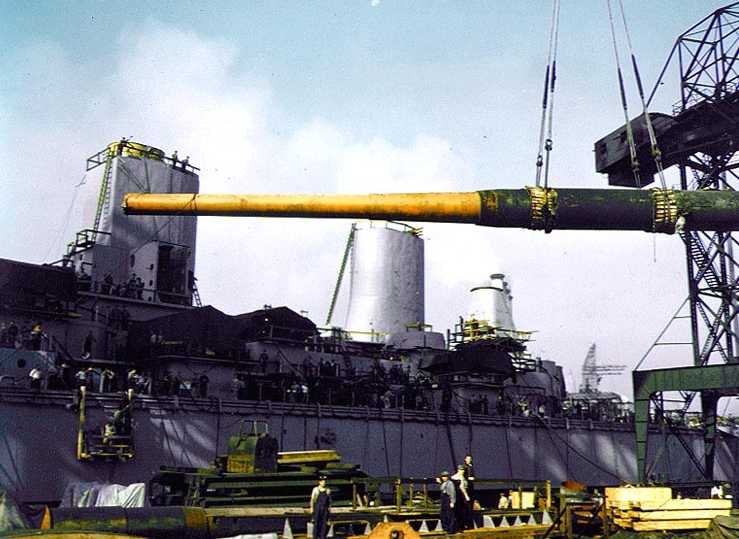
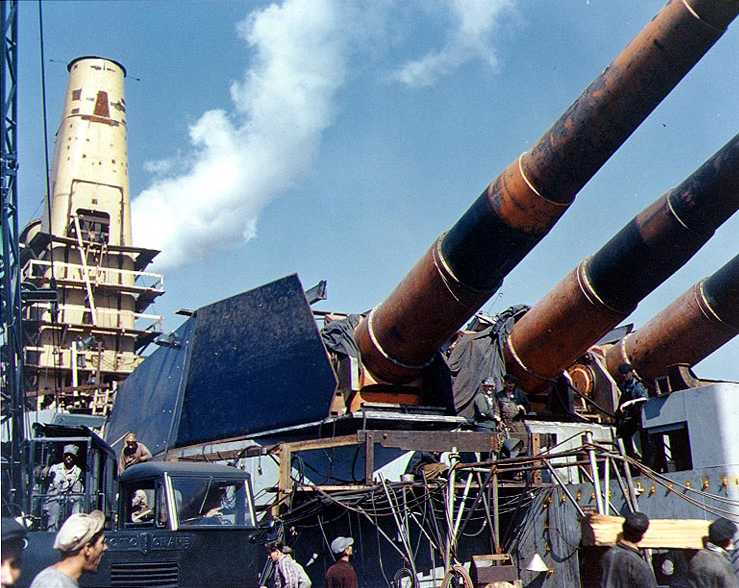




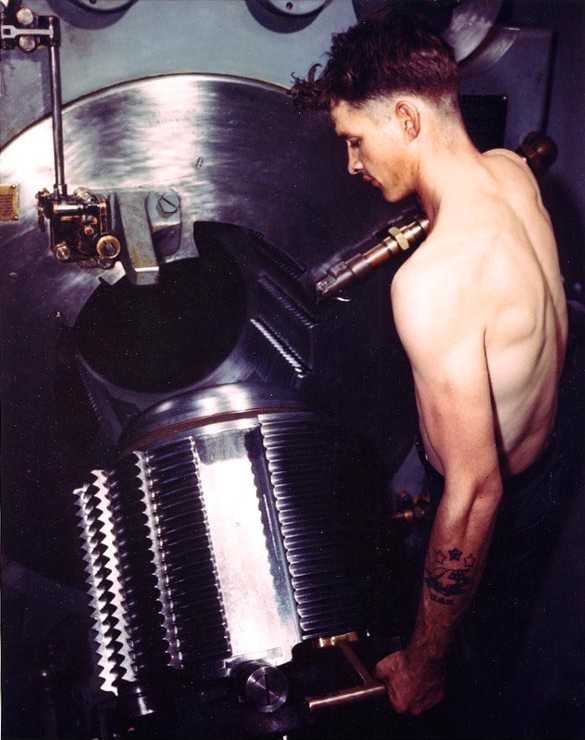

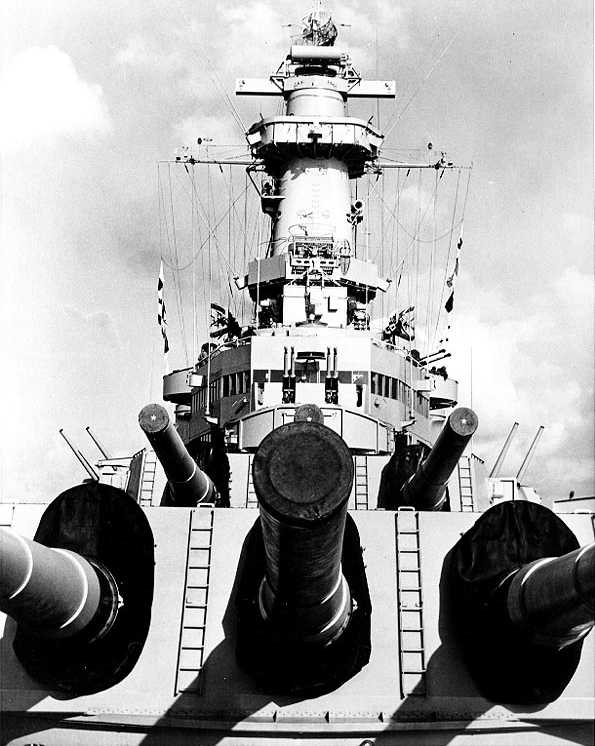
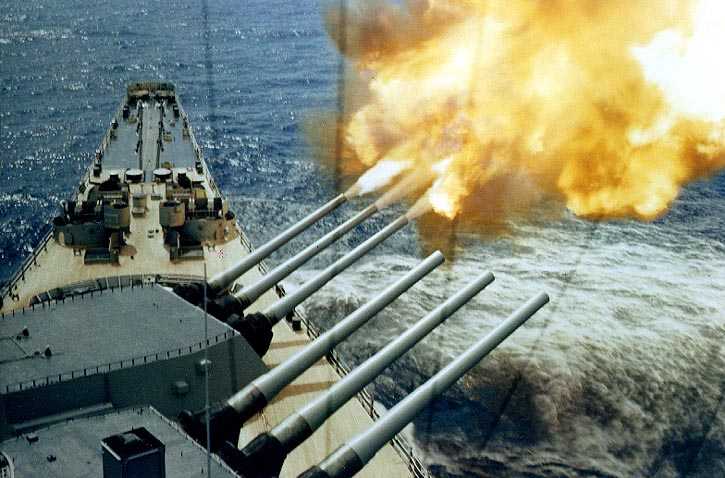
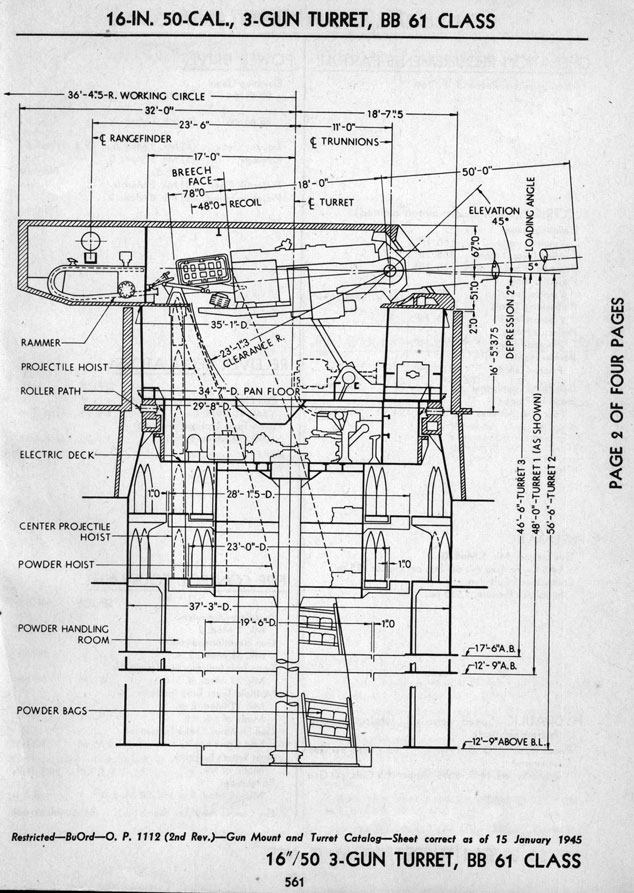
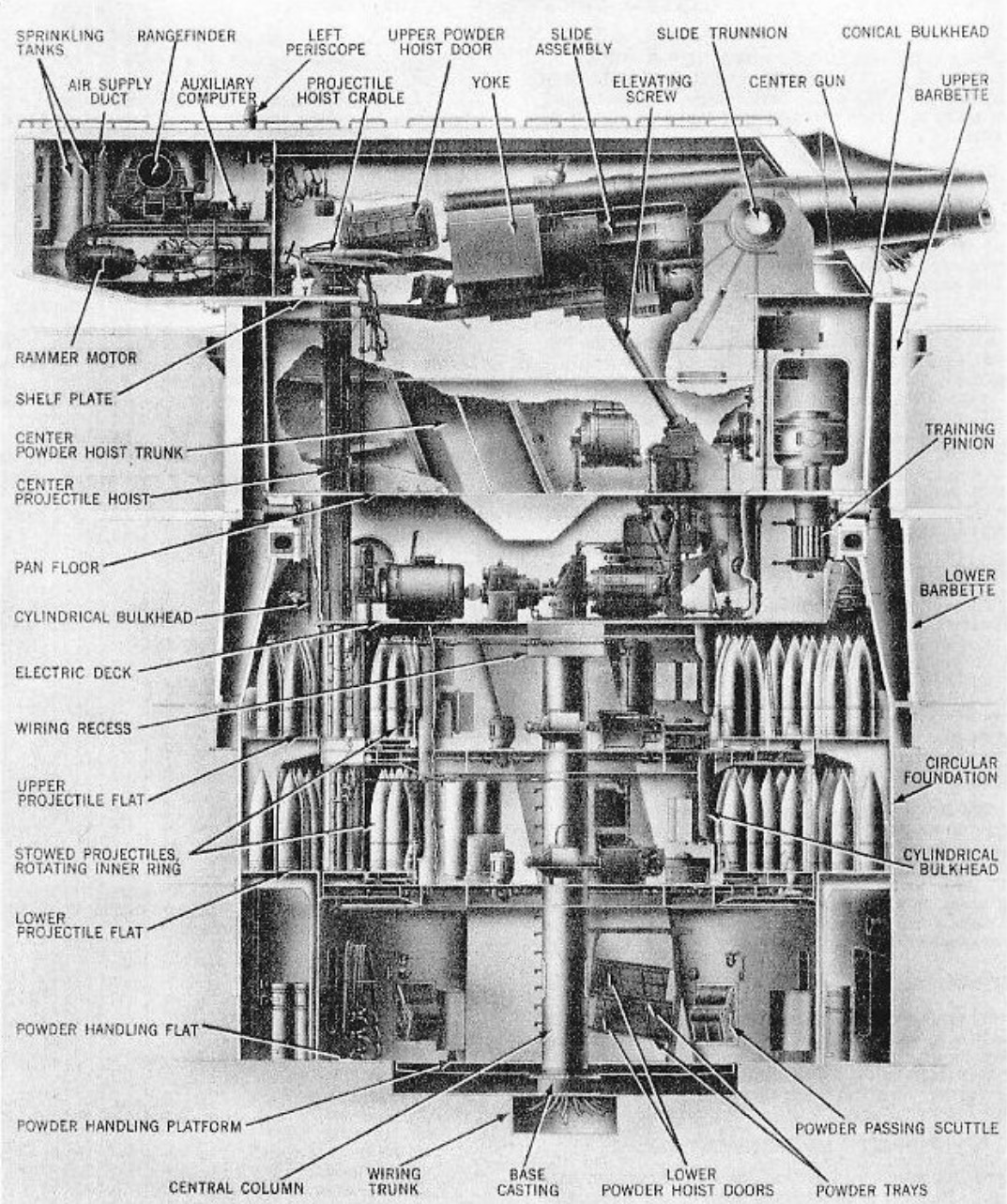
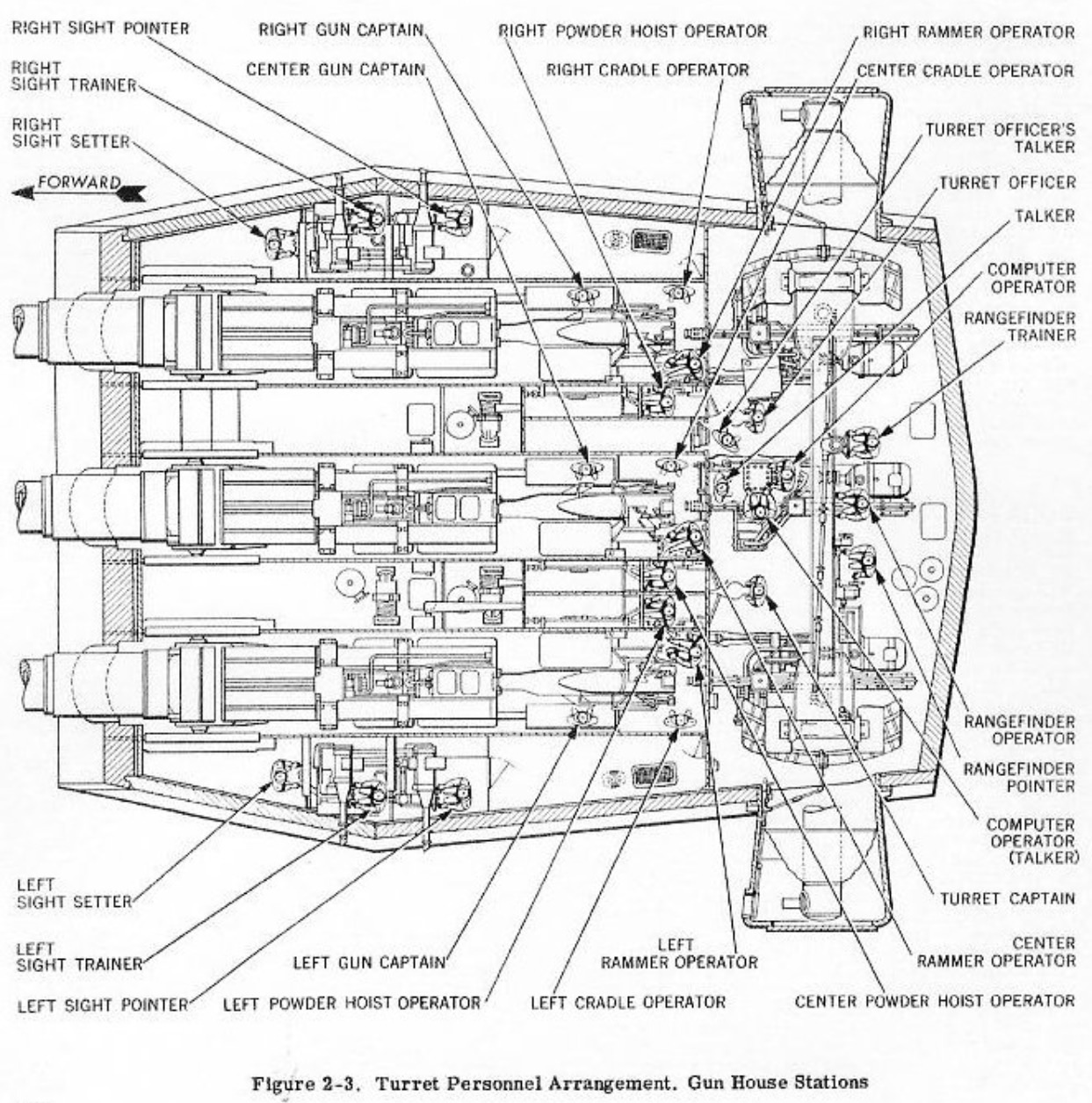

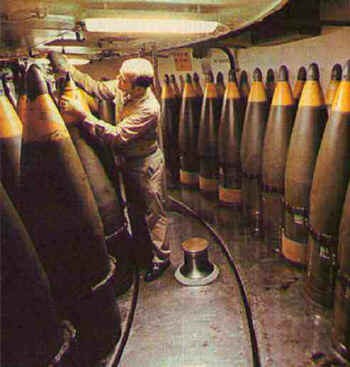
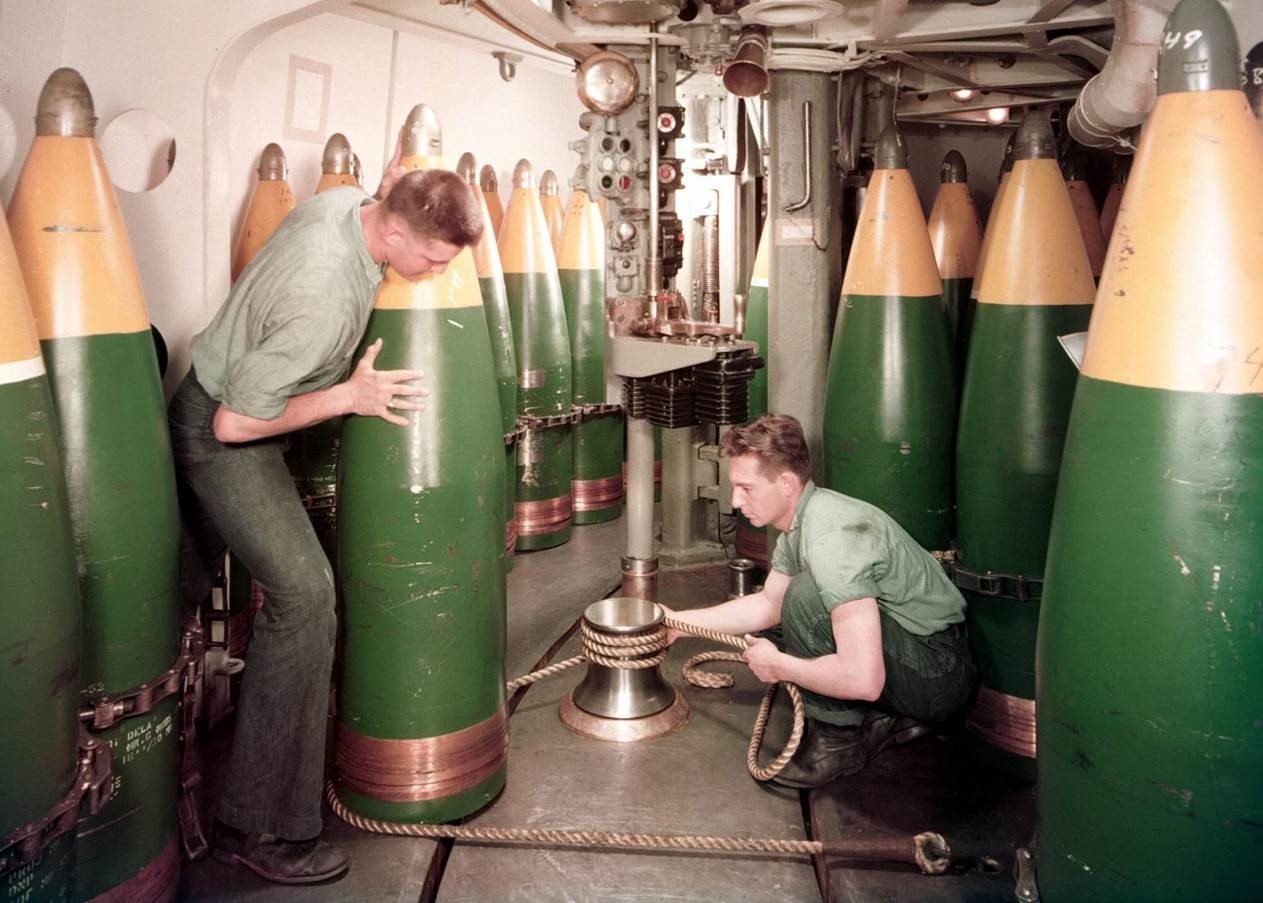
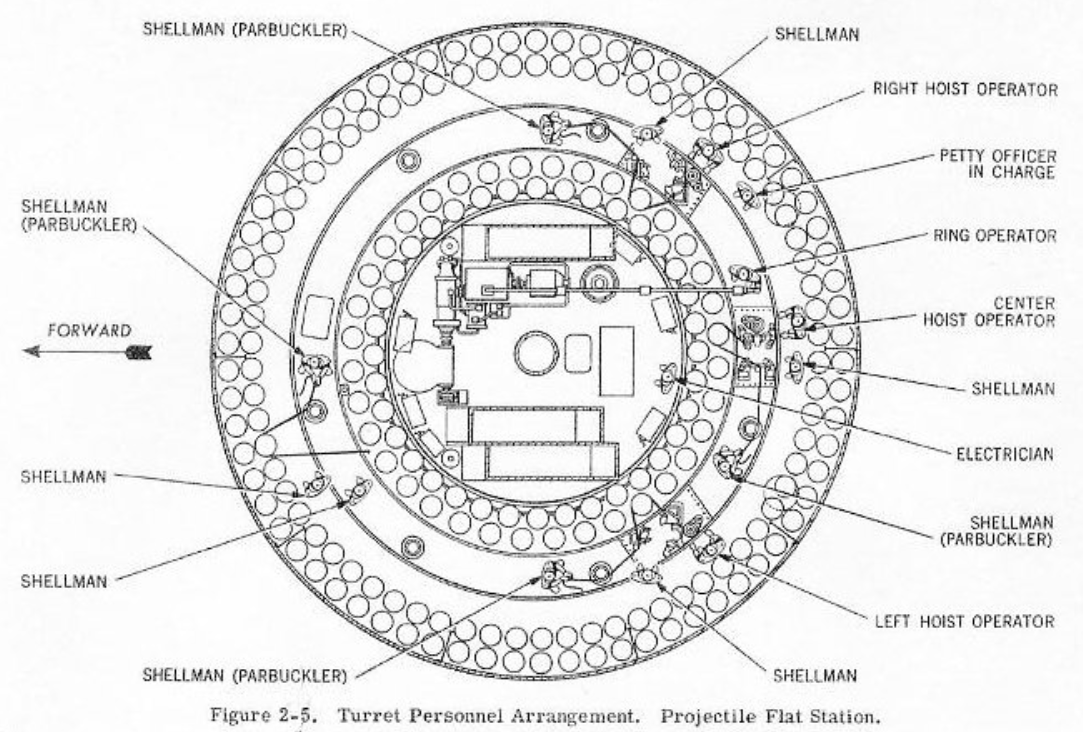

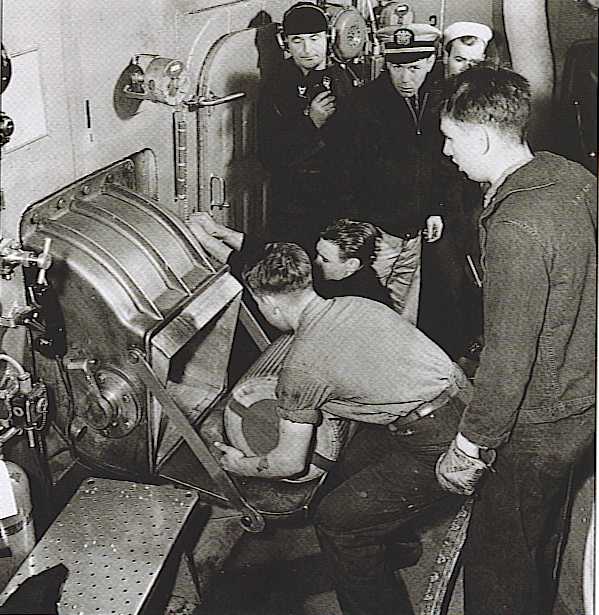

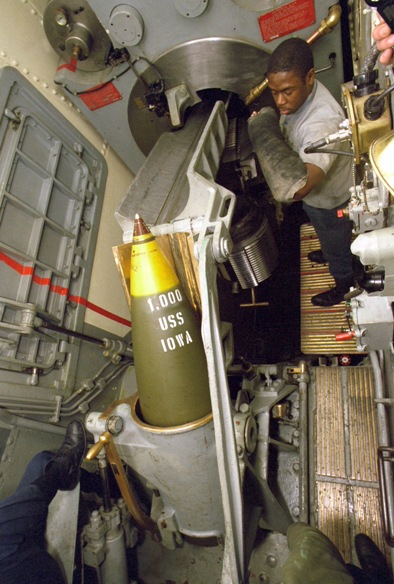
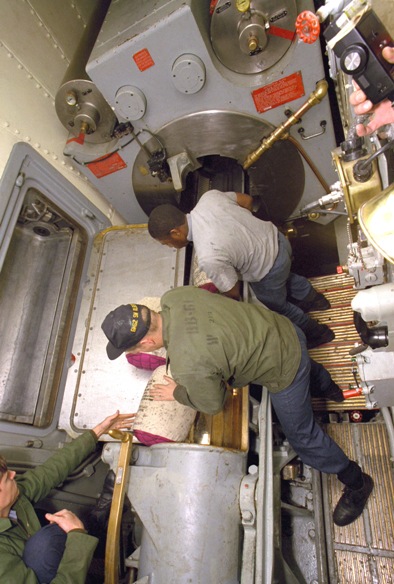


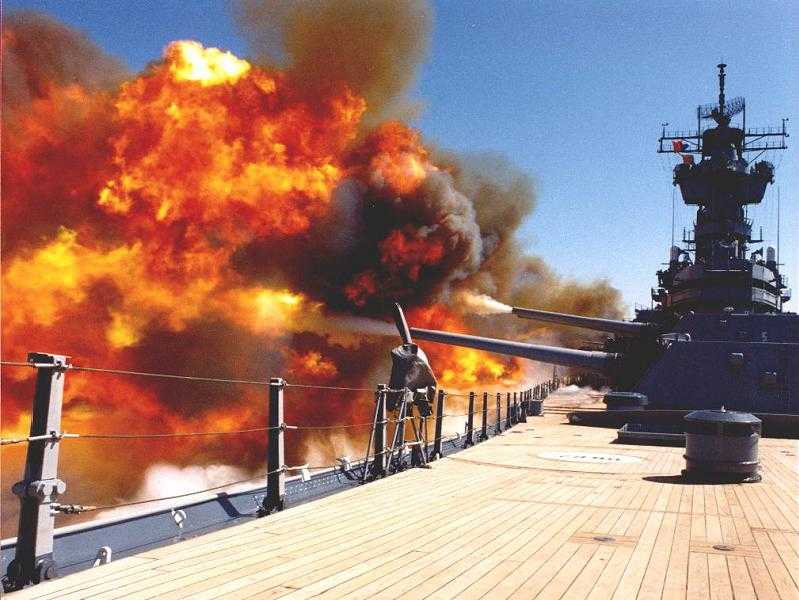
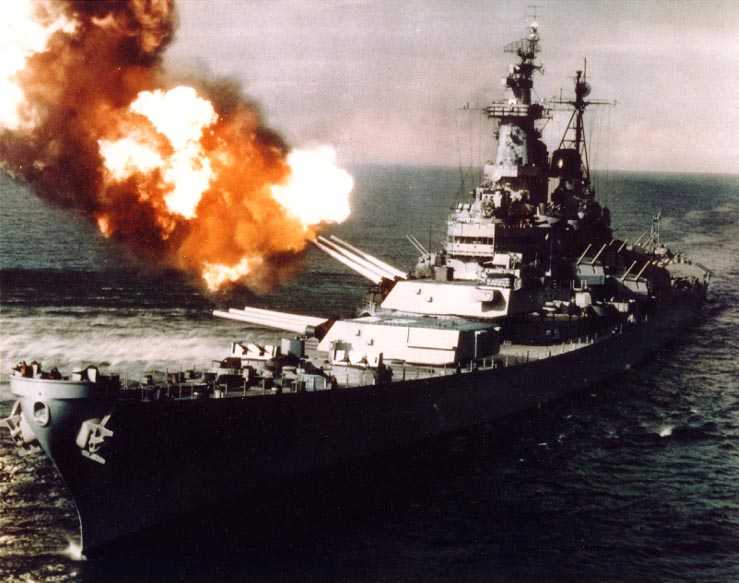
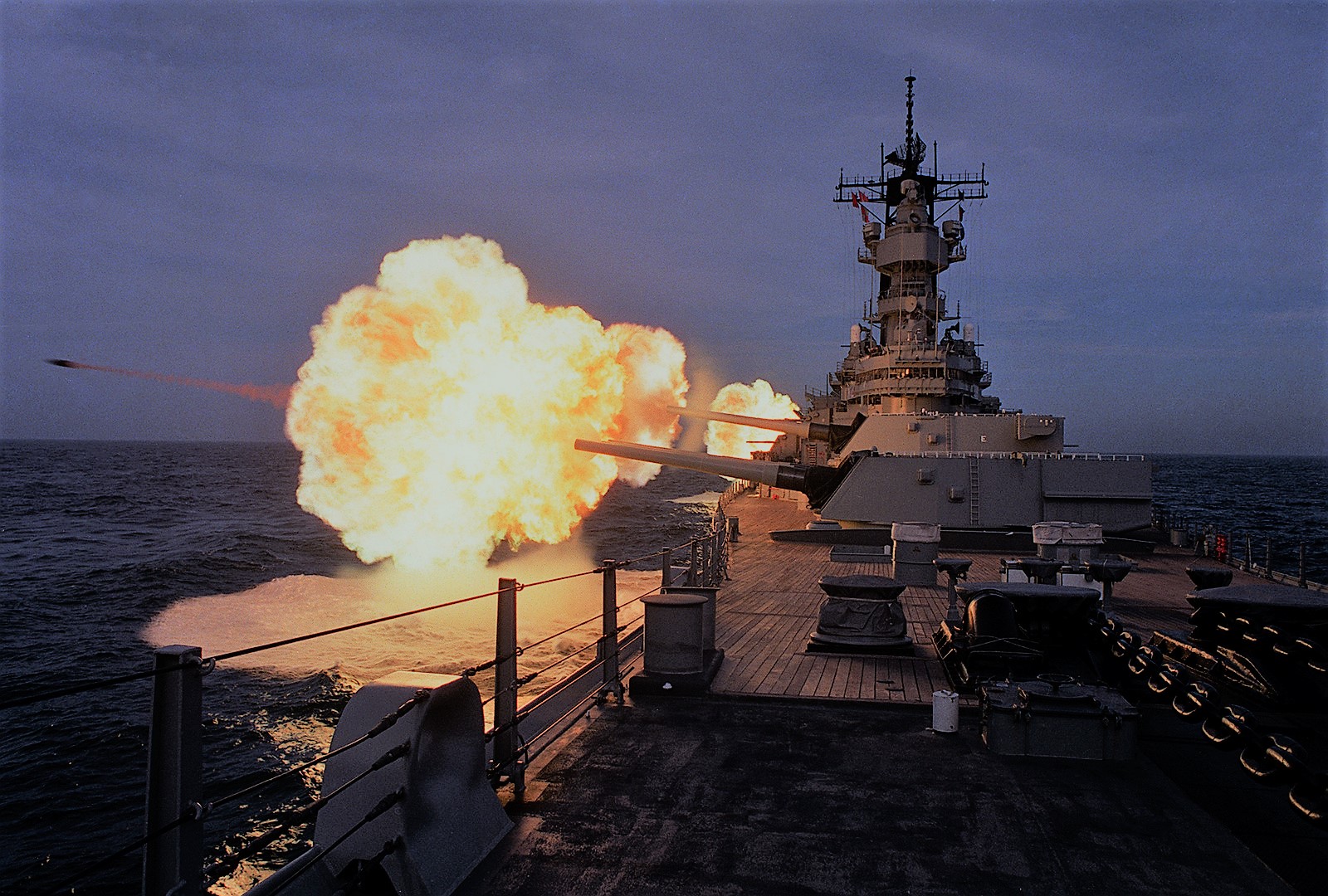


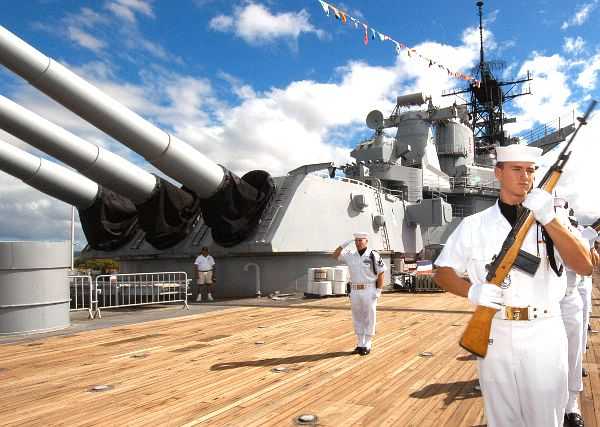
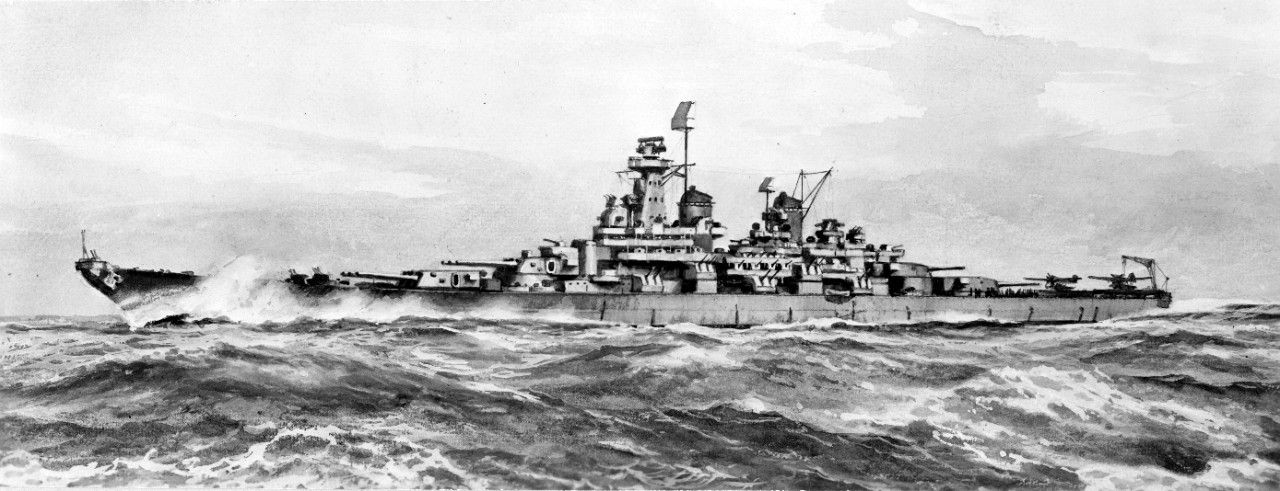


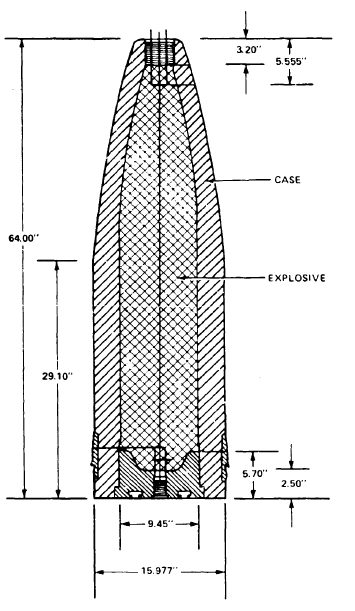
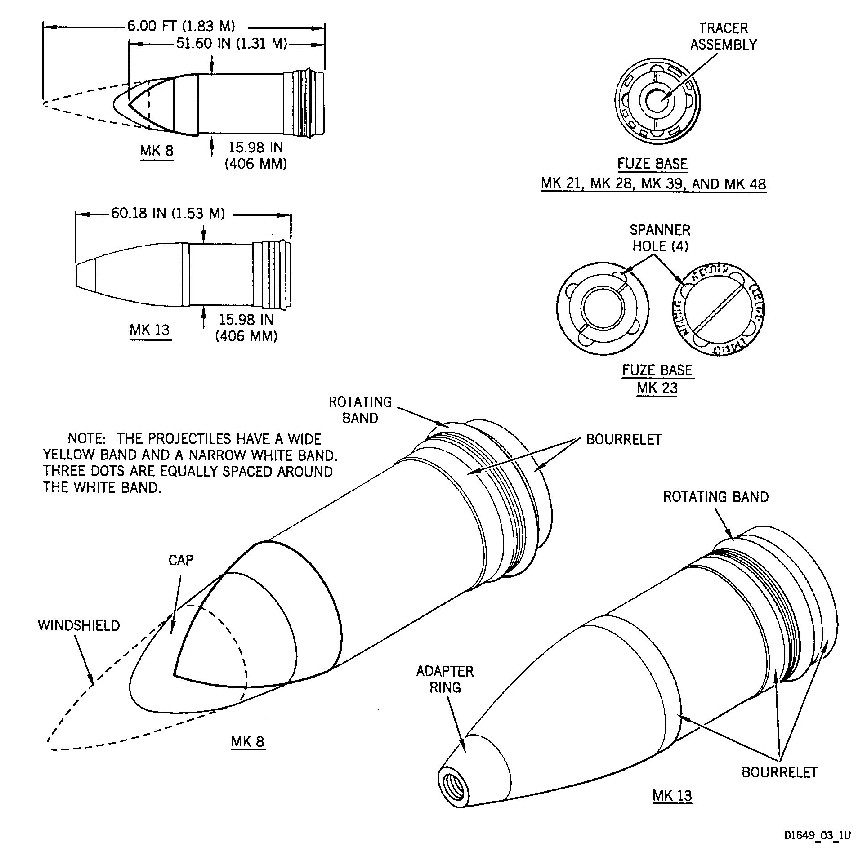

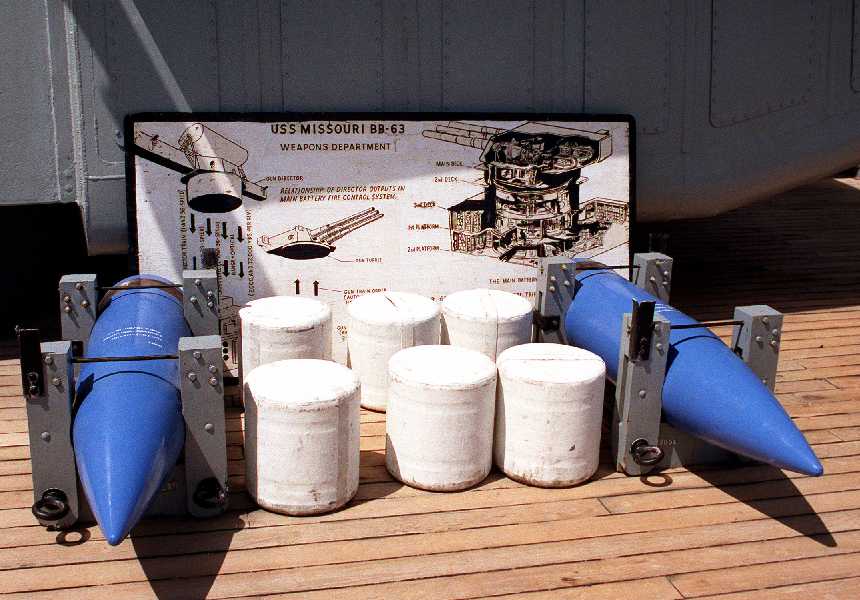


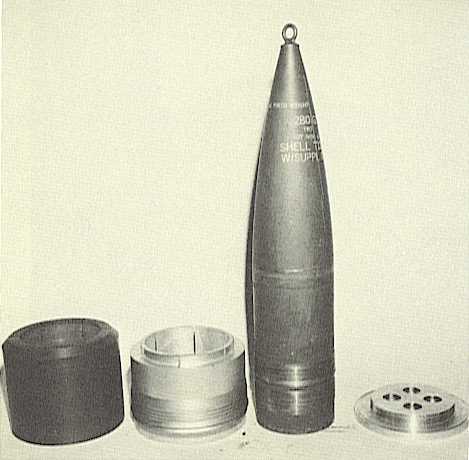
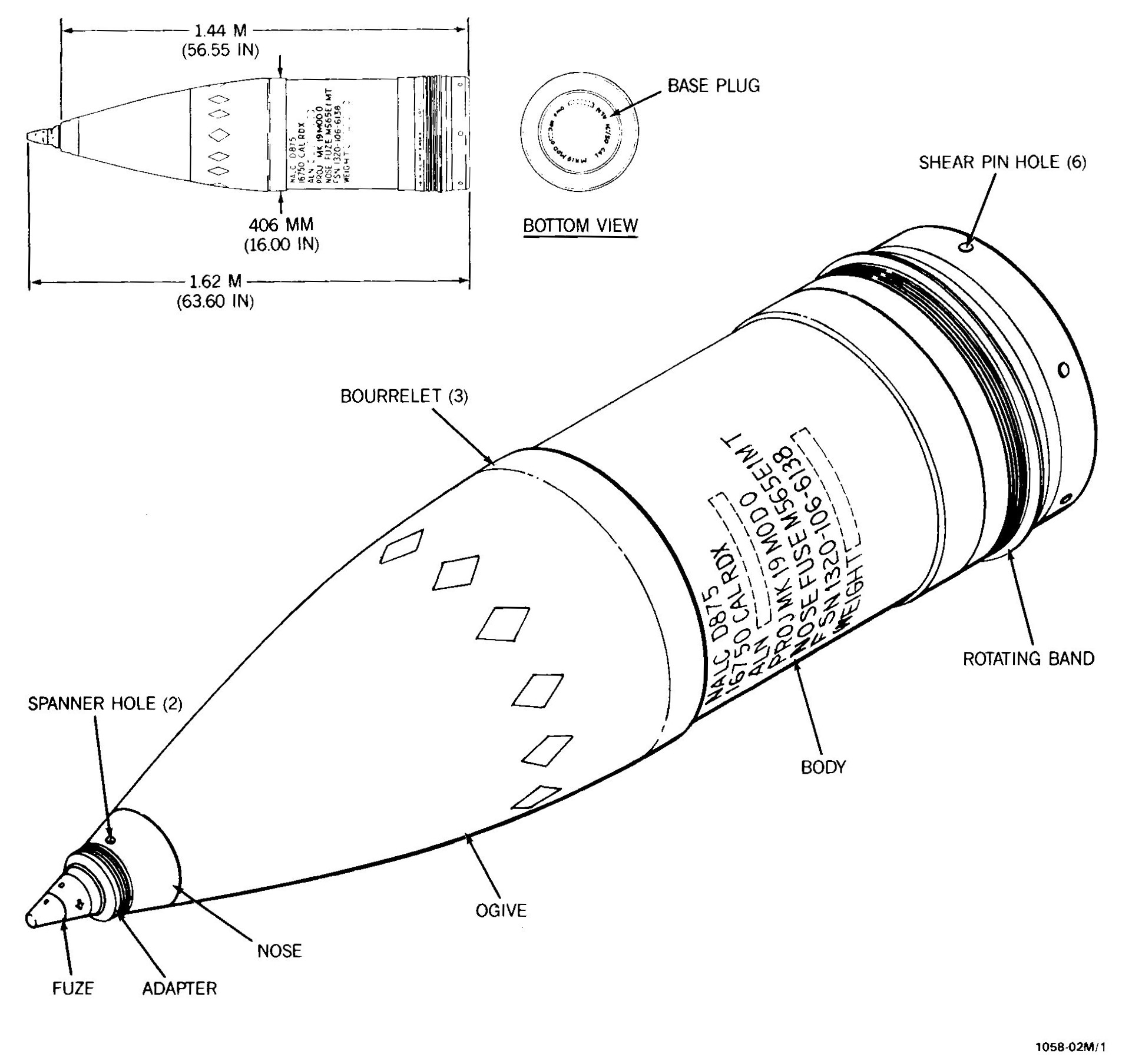



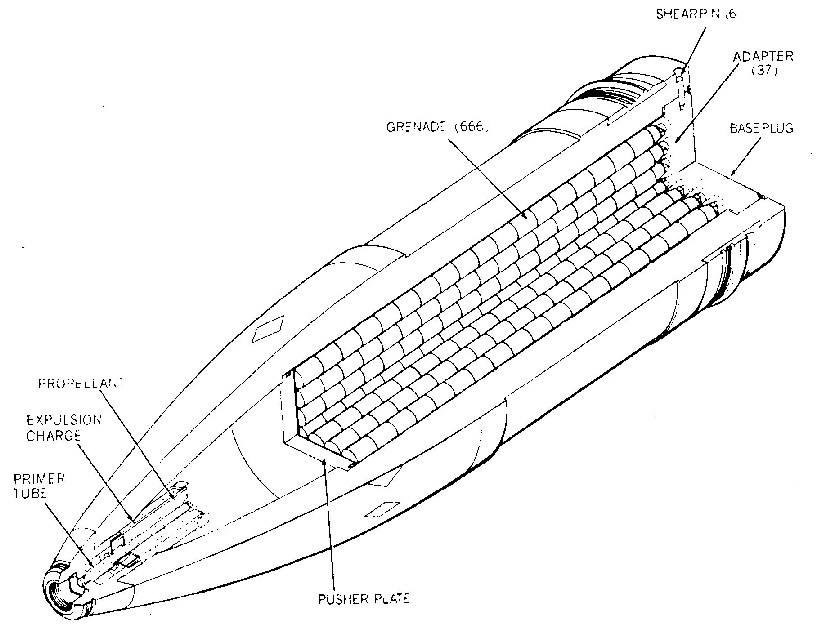

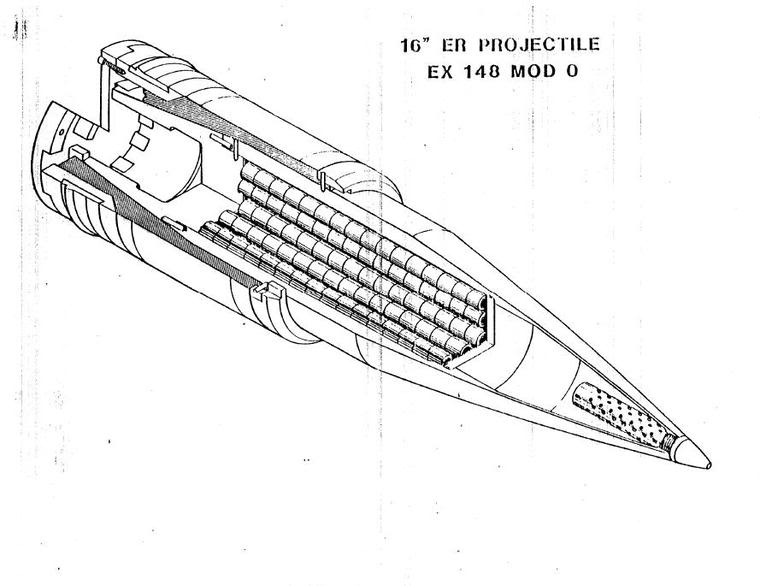
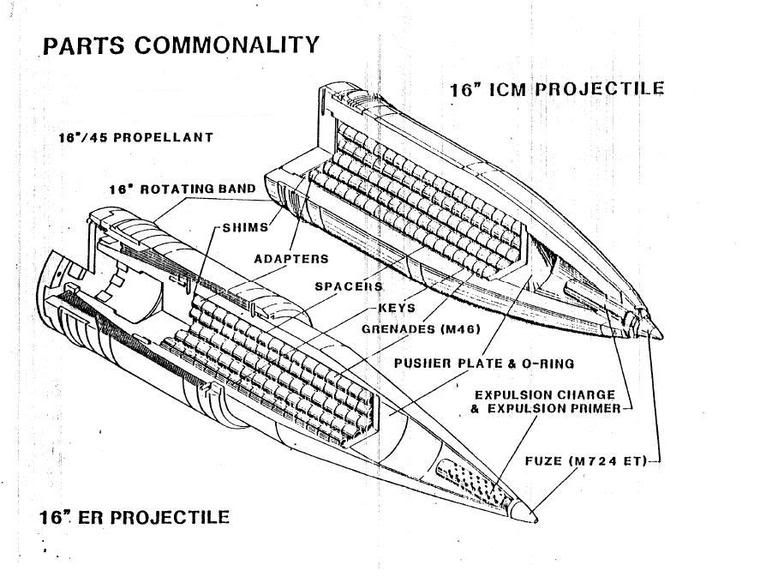
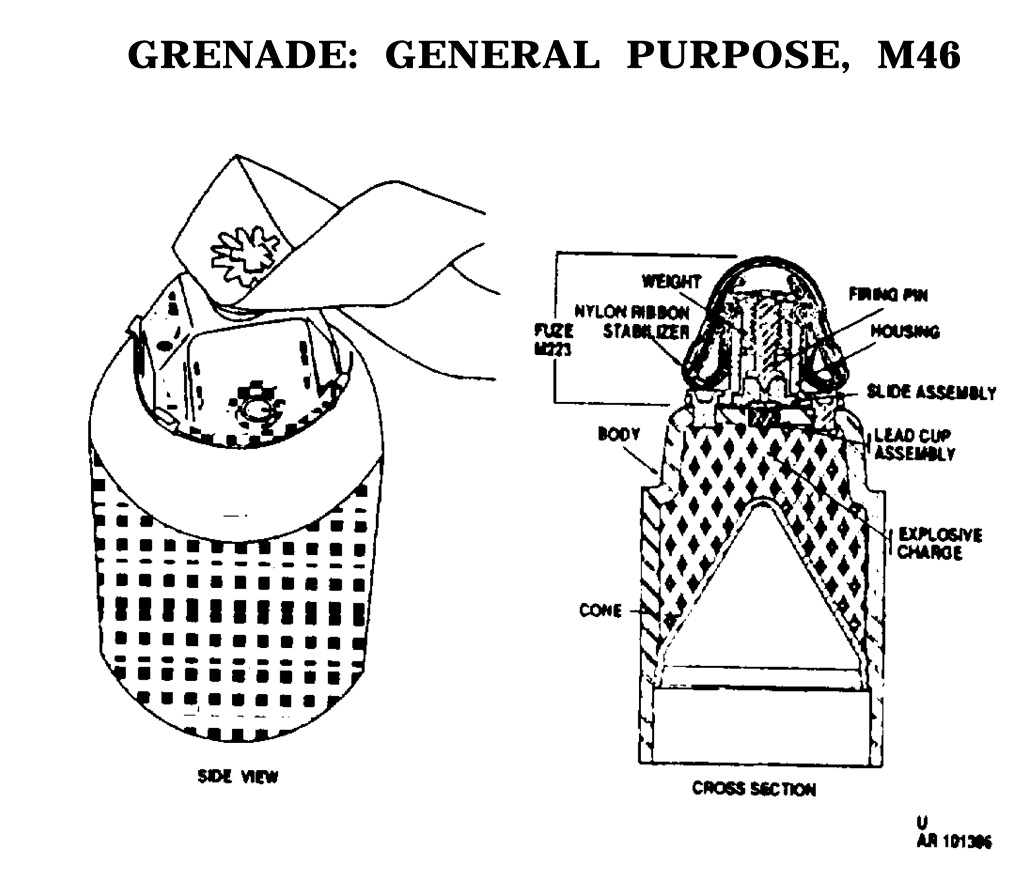


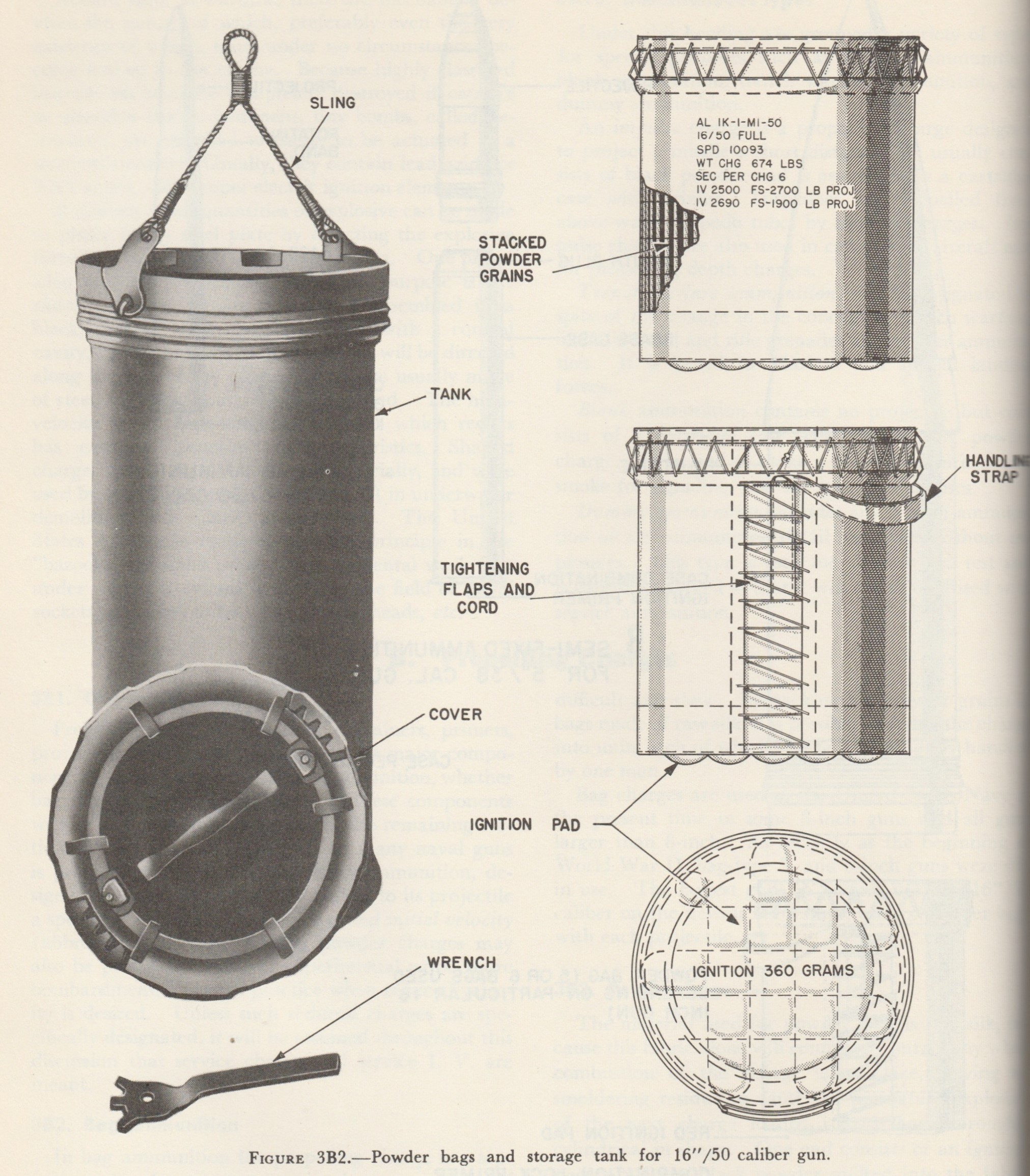

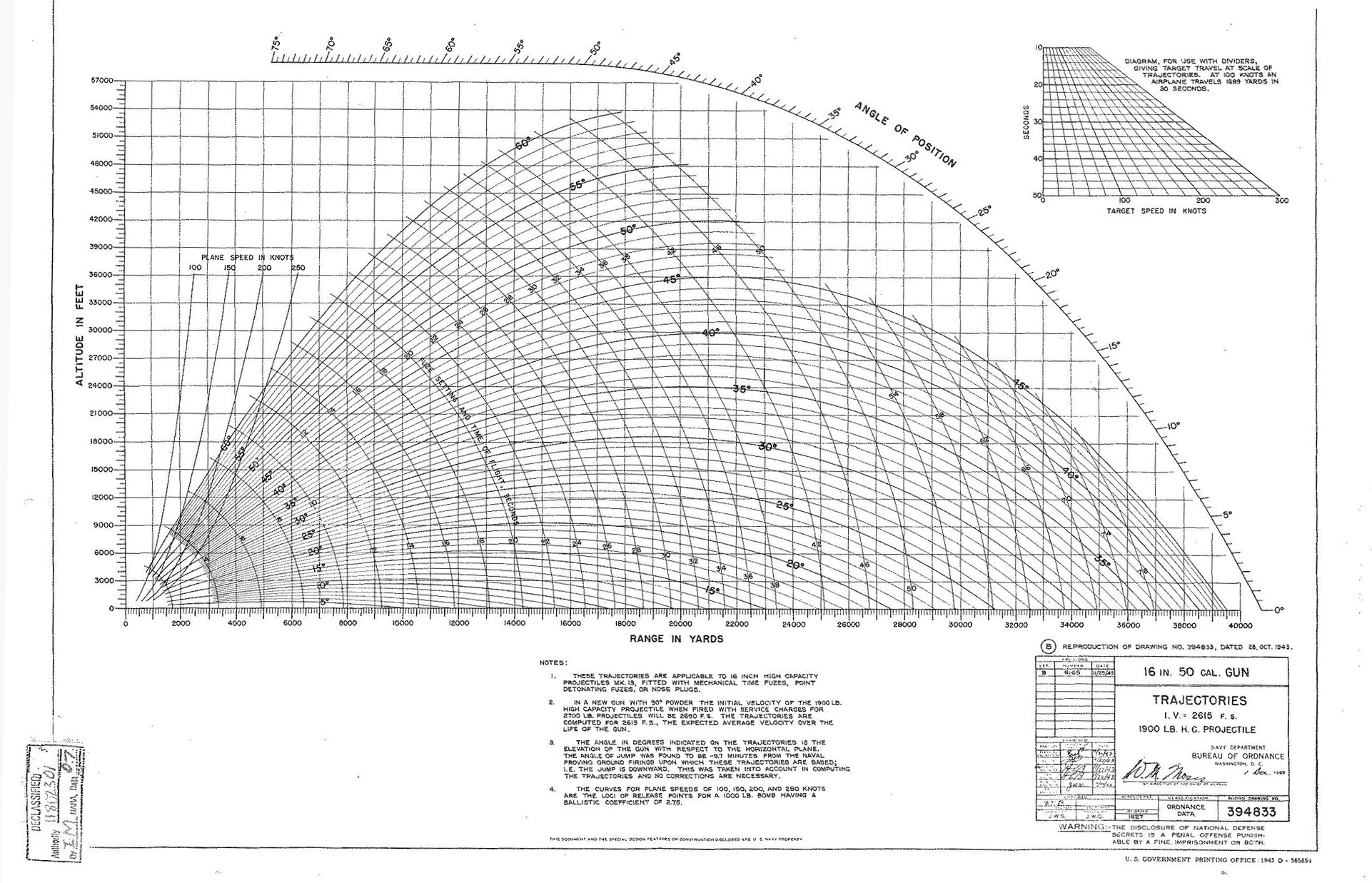
"Naval Weapons of World War Two" by John Campbell
"Powder and Propellants: Energetic Materials at Indian Head, Maryland, 1890-2001" by Rodney Carlisle
"US Battleships: An Illustrated Design History," "US Naval Weapons" and "The Naval Institute Guide to World Naval Weapon Systems 1991/92" all by Norman Friedman
"The Iowa Class Battleships" by Malcolm Muir
"Battleships: United States Battleships, 1935 - 1992" by William H. Garzke, Jr. and Robert O. Dulin, Jr.
"Battleships" by Paul Stillwell
"Iowa Class Battleships" by Robert F. Sumrall
---
"Naval Ordnance and Gunnery - Navpers 16116-B - 1952" by Department of Ordnance and Gunnery, U.S. Naval Academy
"U.S. Navy Bureau of Ordnance in World War II" by Lt. Cmdr. Buford Rowland, USNR, and Lt. William B. Boyd, USNR
"16-Inch Three Gun Turrets BB-61 Class - Ordnance Pamphlet No. 769 - 30 April 1968" by Bureau of Ordnance (BuOrd), Department of the Navy
"16-Inch Range Table, 2,500 F.S. Initial Velocity to 42,345 Yards - Ordnance Pamphlet No. 770 - October 1941" by Bureau of Ordnance (BuOrd), Department of the Navy
"A.A. Range Table for 16-inch, 50-caliber Gun - Ordnance Pamphlet No. 1091 - 11 March 1944" by Bureau of Ordnance (BuOrd), Department of the Navy
"Range Table for 16-inch, 50-caliber Gun, 2,690 F.S. Initial Velocity, 1,900 pound High Capacity Projectile - Ordnance Pamphlet 1100 - 8 December 1943" by Bureau of Ordnance (BuOrd), Department of the Navy
"Performance of Bombs and Projectiles against Shore Installations - Ordnance Pamphlet No. 1172 - 9 May 1944" by Bureau of Ordnance (BuOrd), Department of the Navy
"U.S. Explosive Ordnance - Ordnance Pamphlet No. 1664 - 28 May 1947" by Bureau of Ordnance (BuOrd), Department of the Navy
"Big Guns get Better" by Scot MacDonald in "Surface Warfare" Volume 10, Issue 2 - March/April 1985
---
"Artillery Ammunition - Change No. 11" TM 43-0001-28, Department of the Army (1994)
"Ammunition (Conventional) for Explosive Ordnance Disposal" TM 9-1385-51, Department of the Army (1967)
---
"Accuracy of Gunfire of the Main Batteries of United States Battleships" AMP Report No. 79.2R (SRG-P No. 48), produced in July 1944
"Reactivation of 16-inch Three Gun Turrets in the Battleships" by Art Romano, Naval Sea Systems Command
"Sympathetic Detonation of 16"/50 HC Projectiles" by Michael M. Swisdak, Jr. and Francis B. Porzel, Naval Surface Weapons Center
---
"Department of Defense Appropriations for 1982: Tactical aircraft and missile programs" United States Congress, House Committee on Appropriations, Subcommittee on Department of Defense - Jan 1981
---
Sketches of various projectiles from Ordata
---
Special help by Richard Landgraff, Nathan Okun, Leo Fischer, Matthew Rodchenko and William Jurens
For further information on these weapons, see USS Iowa Website
For a memorial to the men killed in Turret II, see USS Iowa Virtual Memorial
For information about the Mark 38 GFCS, see William E. Genereux Website
For a webpage devoted to a gun from USS New Jersey (BB-62), see Alan Zirkle Website
See Gene Slover's Navy Pages for on-line copies of BuOrd OP
769 "16-Inch Three Gun Turrets BB-61 Class" and OP
1091 "A.A. Range Table for 16-inch 50-caliber Gun"
16" Naval Gunpowder Bags, as made at INAAP, Charlestown, Indiana at Eerie Indiana Blogspot
Battleships during Gulf War I: Missile attack on battleship USS Missouri
---
Part Target - Department of Defense Ammunition NSN Parts: 1320-DA49 - 1320-D591
Unexploded Ordnance (UXO) website
---
U.S. Navy Training Film Major Caliber Guns and Turrets
Turret Crawl on USS Iowa - Great tour of the inside of a turret from bottom to top. Small irk: "W.N.Y." stamping on the breech face actually stands for "Washington Navy Yard" in Washington, D.C. where
the Naval Gun Factory was located.
---
Information on USS Iowa (BB-61) Turret II Incident at the U.S. Naval History and Command Website
"Review of the Department of the Navy's Investigation Into the Gun Turret Explosion Aboard the U.S.S. Iowa": Hearings Before the Committee on Armed Services, United States Senate, One Hundred First Congress, First Session, November 16; December 11, 1989; May 25, 1990,
Volume 4
11 December 2008 - Benchmark
20 July 2009 - Added Ordata as a source, added sketches of Mark 144, Mark 146 and comparison of AP Mark 8 and HC Mark 13
22 November 2009 - Corrected typographical error
06 August 2014 - Added armor thickness and details on 1980s reactivations
22 September 2014 - Minor additions to captions
10 January 2015 - Minor changes
15 May 2015 - Replaced photograph of USS Montana model with artist's conception drawing
30 May 2015 - Redid photograph of USS Iowa and added additional information on projectile stowage
08 July 2015 - Clarified note regarding rear bourrelets
22 November 2015 - Added Firing Cycle Operation
30 May 2016 - Converted to HTML 5 format
17 October 2016 - Added information and photographs of EX-148 projectile and propellant problems.
12 May 2017 - Added information about propellants for Target rounds
22 October 2017 - Added information about 1980s propellants and Accuracy in World War II
19 January 2018 - Reorganized notes
16 December 2018 - Added turret sketch, added to note regarding turret design problem, minor formatting changes
26 April 2019 - Added projectile storage information, sectional view and overhead views of turret, electric deck,
projectile rings and powder handling room
29 May 2019 - Corrected typographical error
03 October 2019 - Added link to U.S. Naval History and Command article
08 November 2019 - Added comments regarding turret crew size and powder crewmen
21 February 2020 - Minor changes
06 May 2020 - Updated image from RIMPAC '90
20 June 2020 - Added information on hoists
03 August 2020 - Added note regarding gun replacement
02 January 2021 - Added photographs of gun pit and liner insertion
21 May 2021 - Added blueprint of 16" (40.6 cm) AP Mark 8 Mod 1 projectile
20 January 2022 - Corrected typographical error, minor navigational improvements
06 April 2022 - Noted the date of the last salvo, added constructional sketch of 16"/50 (40.6 cm) gun, added photograph of
Improved HC Mark 147(?) and sketches of HE Mark 19, added HE Mark 19 projectile data, added fuze information and other
details for projectiles, comment about aging of D846 propellant, added 1989 proof pressures, added sketch of container and powder
bag, added to table of 1981 inventory, added cost of HC projectile, adjusted bag weights, comment about the size of reduced charges
and added link to "Turret Crawl" and listed other data sources
01 June 2022 - Added sketches of M43A1 and M46 Grenade sub-munitions, note about Target Mark 18
17 July 2022 - Added note about the number of powder magazines, minor additions to Ammunition section
16 October 2022 - Fixed broken link to point at Gun Training Film, minor changes to the Description Section
14 January 2023 - Added trajectory chart for HC Mark 13
22 February 2023 - Minor changes for clarity
07 April 2023 - Added link to Battleships during Gulf War I and Time of Flight / Maximum Ordinate to Range Tables
09 August 2023 - Added Striking Velocity to Range Tables
19 September 2024 - Added comment about the Target Mark 18 projectiles
